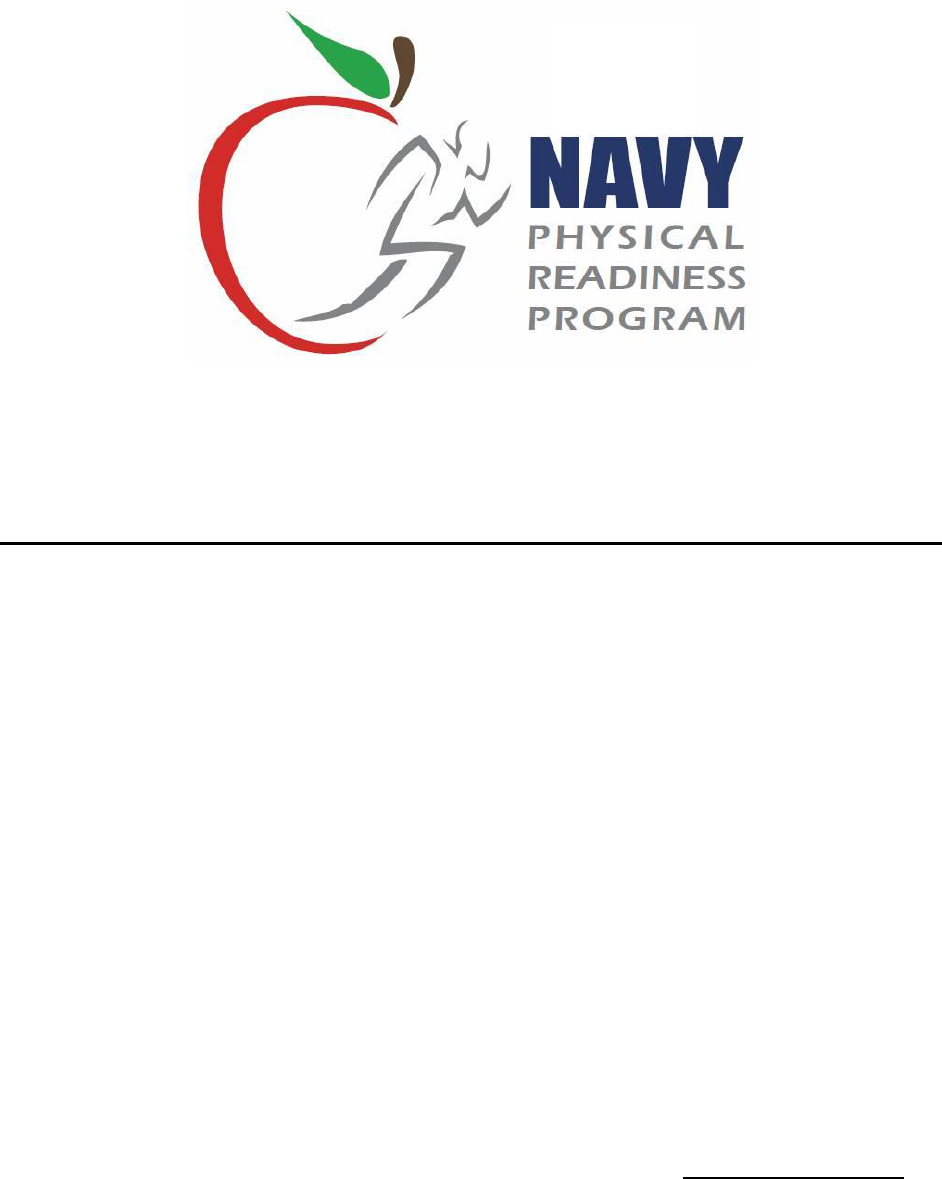
JAN 2023
1
GUIDE 9
COMMAND/UNIT PHYSICAL
TRAINING (PT) AND FITNESS
ENHANCEMENT PROGRAM (FEP)
_____APPROVED ___
THOMAS P. YAVORSKI
N171 BRANCH HEAD
JAN 2023
2
Table of Contents
Page
Section 1: Command Physical Readiness Program Overview
1. Overview………………………………………………………………………………….... 4
2. Program Strategies……………………………………………………………………….. 4
3. Medical Screening………………………………………………………………………… 4
4. Command/Unit Physical Training (PT)…………………………………………………. 4
5. Procedures………………………………………………………………………………… 4
6. Commercial Programs…………………………………………………………………… 5
7. Emergency Response Plan (ERP)……………………………………………………... 5
Section 2: Fitness Enhancement Program (FEP) Overview
1. Overview…………………………………………………………………………………… 6
2. Program Administration………………………………………………………………….. 6
3. Lessons Learned/Best Practices………………………………………………………… 8
Section 3: Activity Guidelines and Physical Training (PT) Components
1. Purpose……………………………………………………………………………………..10
2. Components of Fitness……………………………………………………………………10
3. Basic Fitness Principles………………………………………………………………….. 11
4. Overload and Progression……………………………………………………………….. 13
5. Overtraining and Overreaching………………………………………………………….. 14
6. Cueing Command PT…………………………………………………………………….. 14
7. Exercise Tempo…………………………………………………………………………… 15
8. Movement Compensations………………………………………………………………. 15
9. Overcoming Obstacles to Command PT/FEP…………………………………………. 16
10. Contraindicated Exercises………………………………………………………………. 17
11. Resources…………………………………………………………………………………. 17
Section 4: Command/Unit Physical Training (PT) Components
1. Pre-Physical Activity Questions…………………………………………………………. 20
2. Dynamic Warm-Up (Pillar and Movement Prep)………………………………………. 20
3. Pre-Planned PT Session…………………………………………………………………. 21
4. Regeneration (Cool Down, Stretching, Recovery)…………………………………….. 23
JAN 2023
3
Appendices
A. Pre-Physical Activity Questions for Command/Unit PT and FEP…………………… 25
B. Command PT Regeneration…………………………………………………………….. 27
C. Contraindicated/High Risk Exercises and Stretches…………………………………. 34
D. Sample Workouts………………………………………………………………………… 39
E. Improving PRT Scores…………………………………………………………………… 44
F. FEP Monthly Tracking Log...…………………………………………………………….. 46
G. Glossary of Terms ……………………………………………................................ ….. 48

JAN 2023
4
Section 1: Command Physical Readiness Program Overview
1. Overview. The Command Physical Readiness Program is the command's action
plan to maintain and improve the entire crew's overall health and fitness.
2. Program Strategies. Program strategies include increased opportunities for physical
activity, education, and resources. Program strategies that target the entire command
are more likely to be sustainable and promote healthy lifestyle behaviors.
a. Command/Unit Physical Training (PT) Guidelines for developing PT programs
are provided in Section 3 of this guide.
b. Command/Unit PT Components (Section 4), provides details on the command PT
components. Command Fitness Leaders and Assistant Fitness Leaders (CFL/ACFLs)
need to familiarize themselves with this information before conducting Command/Unit
PT or the Fitness Enhancement Program (FEP).
3. Medical Screening. All members must complete the required medical screening to
confirm health status and screen for physical activity risk factors. CFL/ACFLs must ask
the five Pre-physical Activity Questions before every Command/Unit PT and FEP
session (See Appendix A).
4. Command/Unit PT. Command/Unit PT is any command-led physical activity.
Command/Unit PT must be led by a certified CFL, ACFL, or Morale Welfare Recreation
(MWR) Fitness Specialist per OPNAVINST the 6110.1 Series. Military personnel must
wear the authorized Navy Physical Training Uniform (PTU) or the Optional PTU.
5. Procedures. Below are the procedures for an effective Command/Unit PT session:
a. Schedule a location and time for command members to meet.
b. Publish location and time to all participants.
c. Instruct all participants to bring water (if water is not readily available).
d. Always have a PT session plan. Know in advance what space, activities, and
equipment will be utilized in the PT session.
e. Ensure all ACFLs know their role during the sessions.
f. Take muster before and after the PT session.
g. Read aloud the five Pre-Physical Activity questions before Command/Unit PT
(Appendix A).
h. Start with an appropriate dynamic warm-up exercise routine.

JAN 2023
5
i. Provide instruction on alternative options for personnel with limited exercise
capabilities.
j. End the session with cool down and regeneration (Appendix B).
6. Commercial Programs. The Navy does not endorse any commercialized fitness
programs. CFL/ACFLs are not authorized to display commercial copyrighted programs
(e.g., video, paper, social media, mobile apps) during Command/Unit PT sessions.
7. Emergency Response Plan. An Emergency Response Plan (ERP) must be in place
for contacting emergency medical services when conducting Command/Unit PT on
base. Consult local medical facilities for guidance. At a minimum, the ERP will include
telephone numbers, location of the nearest automated external defibrillator (AED),
procedures for summoning aid, and clear directions for emergency response personnel
to avoid confusion and expedite response times. Include guidance for contacting base
security personnel to assist with unimpeded emergency personnel access to the desired
location. If conducting Command/Unit PT at a MWR facility (fitness center), default to
the facility’s ERP.

JAN 2023
6
Section 2: Fitness Enhancement Program (FEP) Overview
1. Overview. FEP is a command-wide program to improve physical activity and
nutrition behaviors. Per the OPNAVINST 6110.1 series, Commanding Officers/Officers
in Charge (CO/OICs) must establish and monitor a FEP.
2. Program Administration.
a. Program Management: FEP is managed by the CFL on behalf of the CO. The
CFL is responsible for administering all aspects of the program. ACFLs play an
important role in assisting the CFL in conducting FEP activities, documenting
participation, and monitoring member progress.
b. Program Participation: Any member that fails to meet the Physical Fitness
Assessment (PFA) standards is required to be formally enrolled into FEP. Members
may also participate in FEP by self-referral.
c. Mandated FEP Requirements:
(1) Written Counseling for FEP enrollment. Enlisted members are issued a
NAVPERS 1070/613 (Page-13) and Officers are issued a Letter of Notification (LON) to
officially inform them of FEP enrollment and nutrition requirements. Refer to PRP
Guide 3 for additional information.
(2) FEP PT. FEP sessions are only led by designated CFLs, trained ACFLs, or
MWR Fitness Specialists. It is the CFLs responsibility to ensure ACFLs administering
FEP are familiar with the OPNAVINST 6110.1 series and PRP guides. In the event a
member is assigned to a joint command without a certified CFL, FEP may be
administered by the service-equivalent CFL or Fitness Specialist of the sponsoring
military service.
(3) FEP Hours. Unless otherwise directed by the command's
mission/commitments, FEP activities are to be conducted during normal working hours
and a minimum of 3 times per week for a total of 150 minutes or more.
(4) FEP Nutrition. Nutrition plays an important role in a member's performance,
weight management, and disease prevention. Each member enrolled in FEP must
select a nutrition option based on BCA versus PRT failure. Each option must include
goal setting, long-term behavior modification, and ongoing support. The CFL has an
important role in making referrals to registered dietitians/healthcare providers (HCP).
CFLs and ACFLs do not provide diets, recommend caloric intakes, or provide nutrition
counseling. PRP Guide 10: Nutrition Resources provide available and credible nutrition
resources for members to develop an individual plan. CFLs will annotate the nutrition
option selected by the member in the FEP section of PRIMS.

JAN 2023
7
(a) FEP participants that failed their PRT and passed the BCA will select from
one of the options below:
i. Consult with a Registered Dietitian or attend a Navy Nutrition
Performance Class (located with Health Promotions or Nutrition office on base).
Review nutrition guidelines with a dietitian or a health promotion officer/coordinator.
ii. Review Navy Operational Fitness and Fueling Systems (NOFFS)
performance nutrition guidelines and resources. Member may seek assistance from
CFL/ACFL or MWR Fitness Staff to locate NOFFS nutrition resources.
iii. Attend MWR Mission Nutrition Course. Member should coordinate
with CFL/ACFL and MWR Fitness Staff to attend course.
iv. Download the official Navy PFA app and complete the Nutrition self-
study course. Member will report to CFL/ACFL when complete so it can be properly
documented in member’s FEP record.
(b) FEP participants that failed their BCA will select from one of the options
below:
i. ShipShape (Navy Marine Corps Public Health Center Course)
ii. Registered Dietitian (Individual Consult or Class)
iii. Nutrition Self-study Course (Official Navy PFA App)
iv. MWR Mission Nutrition Course
v. Commercial Weight Management Program. Review Guide 10: Nutrition
Resources for guidelines.
d. FEP Documentation. All FEP records are the property of the command and are
to be maintained for no less than five years. FEP documents include:
(1) Weekly PT sessions
(2) Weekly body weight weigh-ins
(3) Monthly mock PFA results, including BCA and PRT components
(4) Nutrition education. Maintain documentation of any courses/programs
offered, completed, or declined.
e. FEP Participation and Monitoring. Members are required to remain enrolled in
FEP until passing one mock or official PFA and be within AAS. If a member fails the
BCA and/or PRT and is subsequently medically waived from an event, they will remain
on FEP until they successfully pass a mock or official PFA for the events which they are
medically cleared for.

JAN 2023
8
f. Progress. Progress may be assessed via program participation records and
monthly mock PRT and BCA results. Each member's progress will vary and depend on
members' age, health status, fitness level, and body composition levels.
(1) PRT. Improved mock scores are the number one indicator of improvement
for fitness.
(2) BCA. Members assigned to FEP due to BCA failure must participate in the
FEP mock PRT. Training emphasis should focus on decreasing body fat versus weight
loss. Adequate progress is 1-2 pounds per week or 1-2% body fat per month and
should not exceed more than 5% of body weight in any week.
g. FEP Session Uniform Requirements.
(1) Uniform. The Navy PTU or Optional PTU is the official uniform for
Command/Unit PT, the PFA, and FEP.
(2) Footwear. Shoes will be comfortable and support the planned exercise and
athletic socks are not to exceed mid-calf. Low-cut socks are permitted.
h. Local Resources. Command CFL/ACFLs, Dietitians, local health promotions
personnel, medical department representatives, ShipShape facilitators, and MWR
fitness professionals can help structure a member's program to produce the greatest
benefit.
3. Lessons Learned/Best Practices.
a. Each member requires an individualized plan. The member should play an active
role in developing their plan for obtaining a healthier lifestyle, as well as meeting Navy
physical readiness standards. Monthly data are required to be recorded in PRIMS.
Review each member's progress at least monthly. A FEP plan provides, at a minimum:
(1) Exercise goals: How will the member acquire the recommended amount of
exercise each week?
(2) Nutrition goals: What nutrition resources will be utilized and what are the
goals within that program?
(3) Progress monitoring: FEP tracking logs with weekly PT and body weight
weigh-ins as well as mock BCA and PRT scores reviewed monthly.
b. When possible, partner with MWR for assistance with Command PT and FEP.
MWR fitness specialists are the experts in the field and trained to assist with group and
individualized exercise programs.
JAN 2023
9
c. Promote additional caloric expenditure outside of FEP PT. It is recommended
that members focusing on weight-loss perform daily physical activity. Regular, daily
exercise is required to maintain a healthy weight. All members should strive to increase
activity outside of FEP.
d. Command/Unit and FEP PT Guidance.
(1) Section 3 provides group exercise guidance.
(2) Limit formation runs. Formation runs alter stride lengths, potentially over-
training the least fit and under-training the fittest. Use PRT run times to group members
into three to four like-fitness levels.
(3) Avoid fitness programs that promote overtraining, increasing the risk of
overuse injuries to muscles and joints. Limit long runs and incorporate speed work to
improve run performance.
(4) Avoid contraindicated exercises (Section 4) at all command-led PT sessions.
(5) Promote a variety of activities beyond regimented, group calisthenics, and
formation runs.
(6) Provide members with the resources, knowledge, command direction, and
monitoring to maintain a healthy lifestyle and mission accomplishment.

JAN 2023
10
Section 3: Activity Guidelines and PT Components
1. Purpose. This resource has been developed to assist commands in conducting a
safe and effective fitness program.
2. Components of Fitness.
a. Cardiorespiratory fitness (i.e., Energy System Development [ESD]): The body's
ability to uptake, transport, and utilize oxygen as fuel in working muscles during
sustained exercise. Sailors should perform at least 150 minutes (2 hours and 30
minutes) to 300 minutes (5 hours) per week of moderate-intensity, or 75 minutes (1 hour
and 15 minutes) to 150 minutes (2 hours and 30 minutes) per week of vigorous-intensity
cardiorespiratory activity, or a combination of both.
(1) Command PT sessions should use all of the body's energy systems:
(a) Anaerobic lactic & alactic systems: energy pathways used in the body
when oxygen is absent.
(b) Aerobic system: energy pathway used when oxygen is present.
b. Strength Training (i.e., resistance training): the ability of muscles to exert, absorb,
or neutrally produce a force on external resistance.
(1) Exercises include muscle-strengthening activities that are of moderate or
high intensity. Muscle-strengthening sessions should involve all major muscle groups,
being performed two or more days a week.
(2) Types of muscle contraction:
(a) Eccentric: muscle lengthens.
(b) Concentric: muscle shortens.
(c) Isometric: no change in the length.
(3) Types of resistance training:
(a) Power: ability to move the weight with acceleration.
(b) Muscular Strength: maximum amount of force that a muscle (or muscle
group) can exert against an external resistance.
(c) Muscular Endurance: the ability of a muscle (or muscle group) to exert
force against resistance repeatedly over time.

JAN 2023
11
c. Flexibility and mobility: the ability of a joint to move freely through its full range of
motion.
(1) Flexibility is an important but often overlooked component of exercise.
Include exercises focused on improving flexibility in each PT session. Sessions should
involve all major muscle groups two or more days a week.
(2) A stretching session will be led after the PT session because muscles are
warmer and more pliable after exercise.
(3) Stretching exercises should be slow and controlled instead of fast or bouncy.
(4) There are two forms of stretching that can be performed, static stretching,
which consists of 10-30 second holds per muscle group, and Active-Isolated Stretching
(AIS) that uses the principle of reciprocal inhibition and the muscle’s stretch reflex. The
recommended stretches and procedures for static and AIS stretching is located in
Appendix B.
d. Neuromuscular Exercise: the ability of the central nervous system to send signals
to muscles to contract. Incorporation into PT sessions assist members in increasing
their muscle strength, balance, and movement. Neuromuscular fitness components
includes plyometrics, speed, agility, and quickness.
3. Basic Fitness Principles. CFL/ACFLs should use the FITT (Frequency, Intensity,
Time, and Type) Principle when developing the command’s physical readiness
program. For a list of exercise-related terms, refer to Appendix G.
a. Frequency: The number of training sessions conducted per day or per week. The
frequency of sessions is largely dependent upon the intensity exerted. Higher intensity
sessions are performed less frequently than lower intensity sessions.
b. Intensity: The level of physical effort required to perform an activity at any given
time. There are several ways to measure intensity: Target Heart Rate, Rate of
Perceived Exertion (RPE), the talk test, and repetition max (RM).
(1) Target heart can be calculated by using the maximum heart rate (HR)
equation by subtracting your age from 220. For example, a 26 year old Sailor would
have a max heart rate of 194 beats/minute (220 – 26 = 194). An alternative equation is
the Karvonen formula which takes your resting heart rate into consideration for
maximum heart rate. The Karvonen formula is used to determine your target HR based
on intensity level [(max HR − resting HR) × %Intensity] + resting HR. Knowing your
target heart rate during training allows Sailors to match effort levels to the intended
intensity.
(2) The Talk Test is a common method to monitor exercise intensity. The
method entails determining the intensity of exercise based on the ease of conversation.
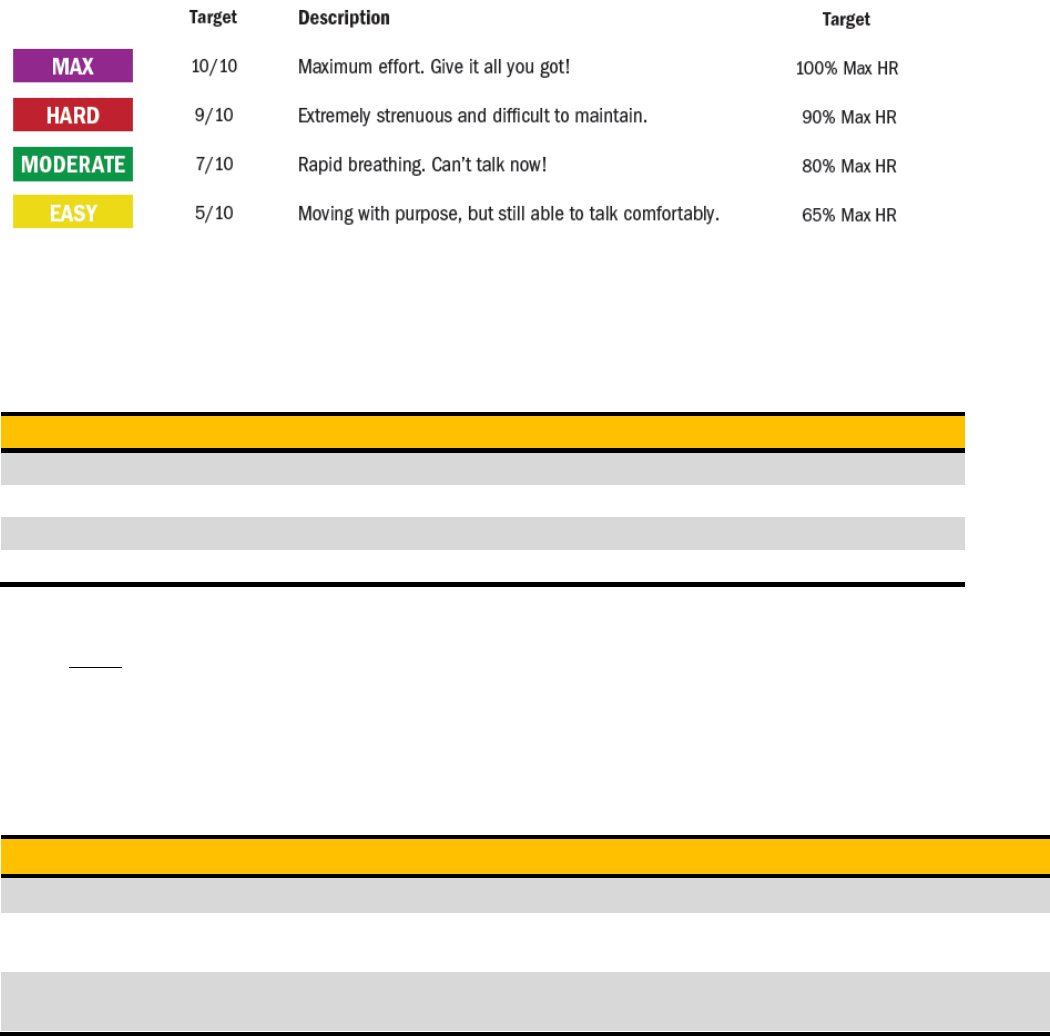
JAN 2023
12
(3) Rate of Perceived Exertion (RPE) is an additional method in which
CFLs/ACFLS can measure a Sailor’s effort by using a scale from 1-10 which measures
the perceived intensity level of a physical activity.
Below is a sample Exercise Intensity chart that incorporates RPE, the Talk Test and
Target Heart Rates.
(4) In addition to establishing appropriate intensity levels, the work-to-rest ratio
can help ensure the exercise intent matches the desired outcome. Table 1 depicts the
amount of work (i.e., exercise) and rest.
Table 1: Recommended Work:Rest Ratio Based on Exercise Intensity
Intensity of Drill
Duration of Drill
Work: Rest Ratio
90-100%
0-6 seconds
1:12 to 1:20
75-90%
6-30 seconds
1:3 to 1:5
30-75%
30 seconds to 3 minutes
1:3 to 1:4
20-30%
>3 minutes
1:1 to 1:3
c. Time: The number of minutes of activity.
(1) The amount of time depends on the intensity. The more intense the
exercise, the shorter the time. Examples of training types and duration is displayed in
Table 2.
Table 2: Recommended Duration and Rest intervals for Training Type
Training Type
Intensity Level
Recommended Duration
Recommended Rest
Interval
High
20-30 minutes
3-5 minutes between interval
Circuit Training
Moderate to High
20-30 minutes
30-90 seconds between rests
between sets
Strength Training
Moderate
30 minutes
30 seconds - 2 minutes
between sets
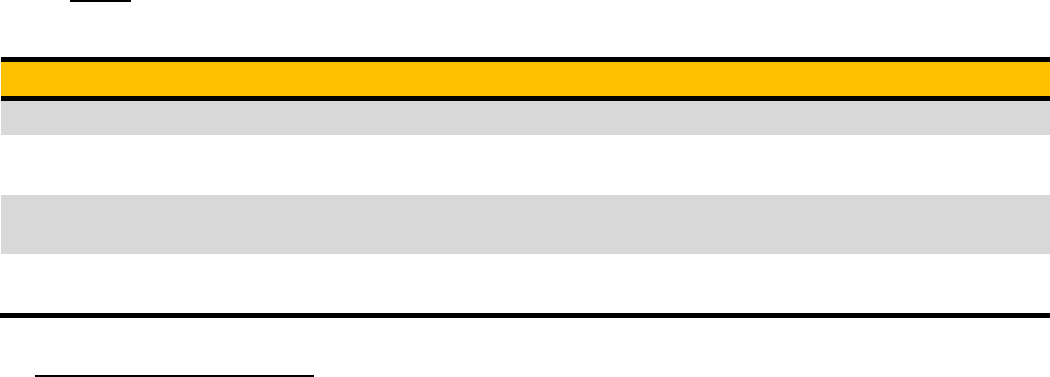
JAN 2023
13
d. Type: The actual activity performed.
Table 3: FITT Principle for Cardiorespiratory, Strength Training, and Flexibility Components
F.I.T.T.
Cardiorespiratory
Strength Training
Flexibility
Frequency
3 + per week
2 + per week
2 + per week
Intensity
Moderate (5-6 RPE)
Vigorous (7-8 RPE)
1-20 + repetitions
3-6 sets
Mild discomfort
Time
150 minutes
Varies
10-30 seconds per stretch
(2-4 sets)
Type
Moderate or vigorous
movement
Movement specific
Joint and muscle group-specific
4. Overload and Progression.
a. To make improvements in fitness, you must physically work at a level beyond
what you are accustomed to. The three factors that are manipulated to induce exercise
overload are frequency, intensity, and time.
b. The rule of progression is to implement an exercise program gradually. Avoid
doing too much, too soon, or too fast to minimize setbacks and injuries.
c. Pay specific attention to time and intensity when starting a workout program.
(1) Initial intensity and time should reflect the beginning fitness level of the
individual. The average aerobic intensity should be that which can be maintained for 15
minutes. For some, this may be a walking, running, or an alternate cardio option.
(2) Always increase time first when increasing overload, then increase the
intensity (e.g., a member able to jog for 15 minutes per session should increase the
time gradually to 30 minutes before increasing speed).
(3) Increase in 5-10% increments per week. For example, if a member is running
1 mile, do not increase above 1.1 miles the following week, or if jogging 15 minutes, do
not increase the following week longer than 16.5 minutes.
(4) More is not always better. After a certain weekly amount of exercise, fitness
improvements are negligible, and the potential for injury increases. Members exhibiting
signs of tendonitis, muscle soreness, continuous ankle, knee, or other pain, or feeling
fatigued regularly, are exercising too often, and may require medical advice.
(5) Quality over Quantity. Monitor participants during activity. Perform
movements in a controlled manner, never place fitness on top of dysfunction. When
form declines, stop the movement or provide an appropriate regression.

JAN 2023
14
(6) After returning from periods of inactivity, it is recommended to progressively
return to exercise. A 5-week reconditioning plan is located at
https://www.navyfitness.org/fitness/5-week-training-plan which can assist with the safe
return to exercise.
5. Overtraining and Overreaching. When intensity, duration, frequency of training, or
any combination of these factors exceeds an individual's capacity for adaptation,
overreaching and overtraining may occur. Exceeding adaptation capacity without
sufficient recovery, normally leads to decrements in physical performance that are
based on complex interactions among several biological systems and psychological
influences.
a. Overreaching refers to short-term training, without sufficient recovery, that
exceeds an individual's capacity. Successful recovery from overreaching can occur
within a few days or up to two weeks with an adequate recovery intervention. Without
recovery periods, overreaching results in a decrement in performance and physical
readiness.
b. Overtraining syndrome is more serious and results from untreated overreaching
that produces long-term impairments in performance and other conditions that may
require medical intervention.
6. Cueing Command PT.
a. As a CFL/ACFL, your role is to analyze and correct members' movements,
providing modifications for difficult or complex movements. During PT sessions, you
should "teach by walking," correcting Sailors' form and posture as needed.
b. CFL/ACFLs are responsible for proper movement execution during command
PT/FEP sessions. Verbal command strategies such as echo counts, military four
counts, and count downs can be utilized to motivate Sailors. These count-based verbal
command strategies must consider the tempo of each exercise to maintain the
appropriate speed to achieve the desired strength adaption. During PT, provide a
"mirror image" approach (e.g., "I lead right, you lead left").
c. Cues can be vocal, visual, or reactive (e.g., tactile).
(1) Vocal cues are used to announce exercise introduction, movement execution,
and correct positioning. Vocal cues should be external cues as much as possible
instead of internal.
(a) External = focus on the outcome of the movement. Examples of external
cues include exploding, pushing, and driving (e.g., squat example, state “push the floor
away”).
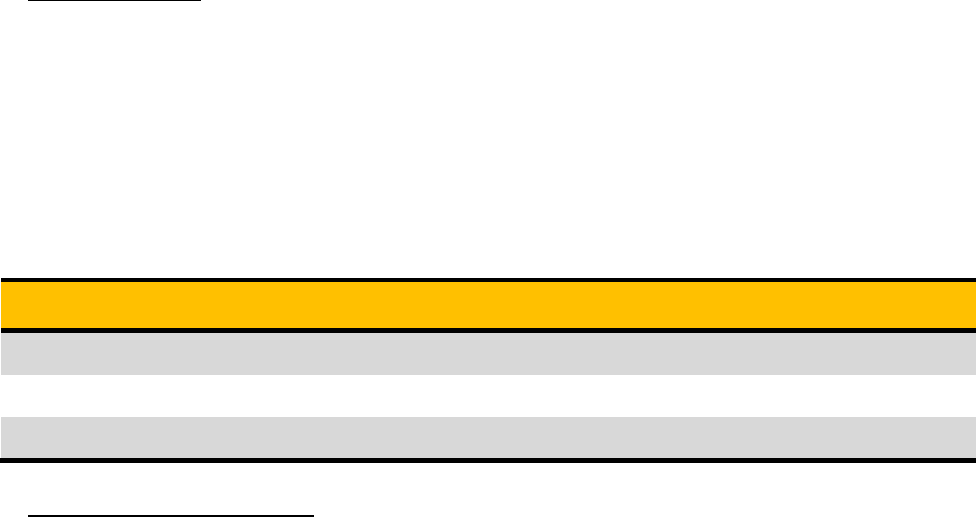
JAN 2023
15
(b) Internal = focus on the body part (e.g., squat example, state “bring your
hips back and down”).
(c) Vocal cues allow CFLs to convey a message through body language and
proper movement patterns. These cues allow Sailors to self-correct improper
movement patterns.
(2) Reactive cues: Reactive cues should be used as a last resort to correct
improper movement patterns. When performing a reactive cue, ask the member for
permission and inform a member of what you plan to do. An example of a reactive cue
is standing in front of a Sailor to signal to them to sit backwards during their squat
instead of forward or adding a mini band above the knees to correct movement
dysfunction.
NOTE: CFL/ACFLs should never manipulate a Sailor into the ideal position.
7. Exercise Tempo. There are three numbers that can be indicated for exercises that
should be performed at a specific tempo/count: eccentric (muscle lengthens), isometric
(no movement), and concentric (muscle shortens). Maintaining exercise tempo assists
in achieving the associated strength gain. For example, if the tempo is 2:1:2, the
muscle will lengthen for 2 seconds (eccentric movement), pause for 1 second (isometric
movement), followed by 2 seconds of muscle shortening (concentric movement). When
applied to push-ups, it is 2 seconds down, 1 second hold at the bottom, and 2 seconds
up to return to the starting position. The prescribed tempo for endurance, strength, and
power exercises is found in Table 4.
Table 4: Exercise Tempo for Endurance, Strength, and Power Exercises
Training Outcome
Eccentric
(seconds)
Isometric
(seconds)
Concentric
(seconds)
Endurance
2-6+
1-2
1-2
Strength
1-2
0-1
1-2
Power
Explosive
N/A
Explosive
8. Movement Compensations.
a. A movement compensation is any deviation from optimal patterns and
recruitment strategies. Movement compensations are caused by decreased or
increased muscle activation, limited joint mobility and/or stability, and inappropriate joint
movement sequencing.
b. As a CFL/ACFL, your role in identifying movement compensations includes:
(1) Recognition: Ability to identify poor movement quality.
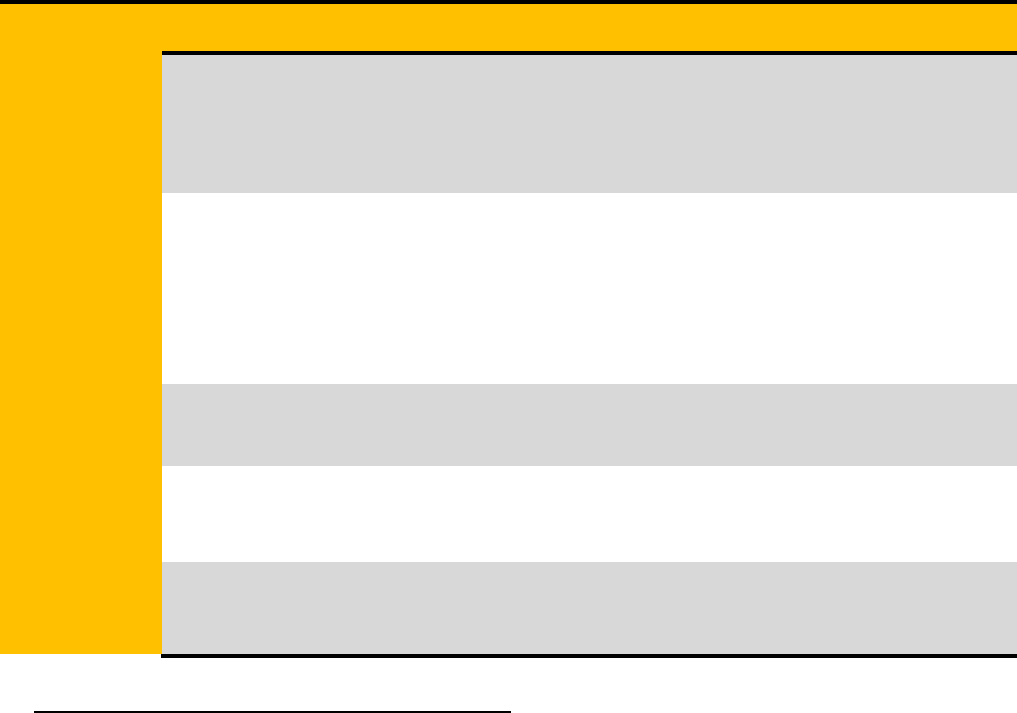
JAN 2023
16
(2) Trial and error: Utilization of cues to correct less than optimal movement
patterns.
(3) Strategic correction: Ability to apply coaching cues to correct compensation.
c. Table 5 provides examples of the common compensations and sample corrective
cues.
Table 5: Common Movement Compensations and Corrective Cues
Movement
Compensation
Example
What to look for?
Corrective Cue
Optimal Position
Weight shifts
Forward: knee-
dominant squat
Backward: hip
dominant squat
Heels slightly lift off the
ground
Toe movement in the
shoe
Uncoordinated hip and
knee flexion
Standing weight
shift
Cue arch
Exaggerate the
compensation
Weight centered on
the arch of the leg
with toes engaged
Pelvic tilts
Anterior tilt: extension
of lower back
Posterior tilt: flexion
of the lower back
Lateral tilt: lateral
flexion of the hip
Excessive extension or
flexion in low-back
Excessive tone/muscle
size in low-back
Cue pelvis and
hinge
Facilitate neutral
spine
Torso activation
Pelvis sitting in a
neutral position
Head position
Extension of the neck
Cervical
extension/flexion
Manual head tilt
Remove/minimize
visual
Head facing
forward in a neutral
position
Thoracic
hinge
Thoracic extension
and rib flare
Slight cervical
extension
Rib flare
Close down the ribs
Torso activation
Neutral spine with
ribs closed
Knee collapse
One or both knees
collapse to the center
Knee movement during
exercise
Exaggerate the
compensation
Sync hip/knee
sequencing
Feet and knee in
line, wider than hip-
width
9. Overcoming Obstacles to Command PT/FEP. CFL/ACFLs will experience obstacles
when trying to assist Sailors in improving physical readiness. Tips are provided for
assisting with PT obstacles in Table 6. CFLs should remember that when dealing with
these obstacles, they should always keep their CO informed.
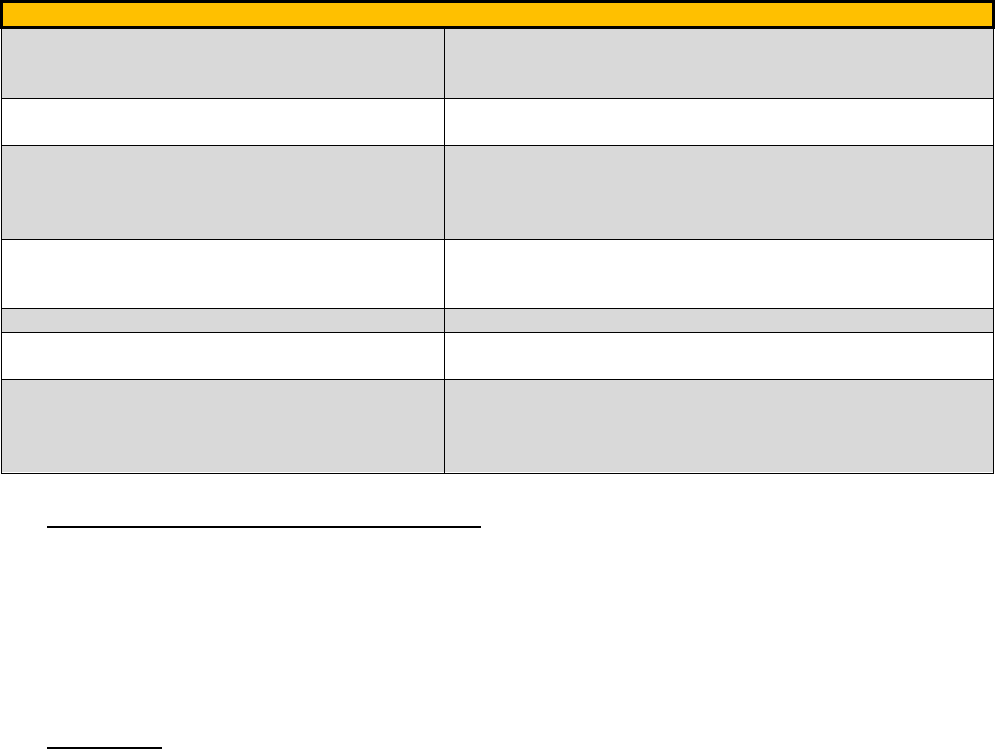
JAN 2023
17
Table 6: Strategies for Overcoming Common Obstacles to PT
Obstacle
Strategy
I do not have time (work, family)
Plan ahead. Make time and mark it on your calendar. Aim
for earlier in the day to prevent last minute commitments
from becoming an excuse.
I do not have anyone to go with
Develop a buddy system. Members are more likely to PT
on off days if someone else is waiting for them.
I am so tired after work
Schedule activity early in the day.
Look at eating patterns. Have you fueled properly during
the day to give you consistent energy? Look at sleep
habits as well. Can you go to bed one hour earlier?
I have small children that I have to get home to
Trade babysitting with a friend. Do exercises with your
children – walking with a stroller, have them ride a bike
while you walk or jog.
The weather…
Use the confined spaces workout indoors.
I do not have access to a gym
A gym is not required. Bodyweight, resistance bands, and
workout videos can be used.
I have to…..
Lose the excuses! This is a priority. Rate it that way in
your day. Once a routine is established, it becomes
second nature, like brushing teeth and getting dressed in
the morning.
10. Contraindicated Exercises and Stretches. Contraindicated movements are
potentially dangerous and may lead to injury. Any exercise that incorporates
movements that cause extension or flexion of a joint beyond its normal range involves
excessive, rapid or repetitive twisting around a fixed base, or requires advanced skills or
strength to perform correctly is considered to be contraindicated for command-led PT.
Contraindicated exercises and stretches are to be avoided at all command-led PT
sessions (Appendix C).
11. Resources.
a. There are many fitness resources available to assist with command physical
readiness. MWR fitness professionals can assist in designing and conducting
command/FEP PT sessions. MWR fitness professionals are exercise specialists trained
and qualified to provide individual and group exercise plans. Contact your local MWR
for available services.
b. Additional tools for CFL/ACFLs are the Navy Operational Fitness and Fueling
Series (NOFFS) courses offered aboard Navy installations. NOFFS was developed by
Navy physical readiness stakeholders and industry experts to provide a comprehensive
human performance training system that removes the guesswork. NOFFS is delivered
through three different methods: NOFFS Pre-Designed Series (including free NOFFS
Apps from your smart phone’s app store), NOFFS Educational Courses, and
Customized NOFFS Programming. NOFFS includes pillar prep, movement prep,
plyometrics - speed, agility, and quickness (SAQ), strength training, cardiorespiratory
JAN 2023
18
conditioning (ESD), regeneration (stretching and flexibility), and nutrition (fueling).
CFL/ACFLs have access to certified NOFFS instructors located throughout the fleet to
assist in training on NOFFS and incorporation into command PT. Various NOFFS
programs and courses are available including the following:
(1) The pre-designed NOFFS series:
(a) Operational Series: Designed to assist individuals with maintaining their
physical fitness levels based on various space and equipment restrictions. The
Operational series includes total body workouts, including cardiorespiratory training for
submarines, surface ship, and large decks.
(b) Strength Series: Designed to assist individuals in developing the strength
needed to perform at higher levels through three phases; Build Muscle, Get Strong, and
Get Powerful.
(c) Endurance Series: Designed to assist individuals with breaking through
training plateaus while decreasing injuries often associated with traditional endurance
training.
(d) Sandbag Series: Designed to provide individuals with a training plan that
can be performed in austere environments with limited equipment options. The
Sandbag series assists in developing the raw strength and power needed to meet the
performance demands placed upon Sailors in any environment. Exercise modalities
(e.g., dumbbells, kettlebells) can be supplemented for a sandbag to complete the series'
exercises.
(2) MWR Instructor-led NOFFS Educational Courses:
(a) NOFFS Short Course: Six-hour NOFFS Operational course designed to
provide attendees with the foundation behind the methodology and movements found
throughout the Operational Series.
(b) NOFFS Operational, Strength, Endurance, and Sandbag Labs: Two-hour
labs for each series (Operational, Strength, Endurance, and Sandbag), designed to
educate and instruct participants on the movements in each series.
(c) NOFFS Fueling Strategies: Two-hour course reviewing the fueling
(nutrition) strategies found in the NOFFS system.
(d) NOFFS Operational Course: Five-day course designed to review the
mission, intent, and goal of NOFFS. The course provides attendees with the tools
needed to perform and execute the NOFFS Operational workouts through lectures and
gym sessions.
(3) Certified MWR NOFFS instructors can develop specific NOFFS training

JAN 2023
19
sessions for individuals or commands to enhance physical readiness. Customized
NOFFS programming needs pillar prep, movement prep, plyometric-SAQ, strength
training, ESD, and regeneration components.
(4) For more information on NOFFS and other MWR Fitness programs, visit
http://www.navyfitness.org/ for more details.

JAN 2023
20
Section 4: Command/Unit PT Components
The Navy's operational requirements are infinite and multidimensional, requiring
multiple joint movements and patterns. The movement-based approach should include
a warm-up, strength training, cardiorespiratory conditioning, regeneration, and
complemented by adequate fueling strategies (Refer to Guide 10). All command led PT
sessions consist of the following components in the order provided in Table 7.
Table 7: Recommended Duration of Components of a PT Session
PT Component
Time Requirement
Pre-Physical Activity Questions
N/A
Dynamic Warm-Up (Pillar & Movement Prep)
5 – 10 minutes
Pre-Planned PT Session
20 – 45 minutes
Cool-down
3 – 5 minutes
Regeneration
5 – 10 minutes
1. Pre-Physical Activity Questions. Prior to each command PT and FEP session the
Pre-physical Activity Questions must be asked. The Pre-Physical Activity Questions are
located in Appendix A.
2. Dynamic Warm-Up (Pillar and Movement Prep). Each PT session shall begin with a
pillar and movement prep. The purpose of the warm-up is to adequately prepare the
body for physical activity. The activities performed in the warm-up routine should mimic
the activities that will be performed during the exercise session. The warm-up period
lasts between 5-10 minutes but is driven by workout intensity, Sailor capacity, and
session length. Movements should start with low-intensity and gradually increase in
intensity as the warm-up progresses.
a. Take time to warm-up. Benefits include:
(1) Reducing the potential for muscle and connective tissue injuries.
(2) Increasing blood flow to exercising muscles. The more blood that reaches
the muscles, the easier the delivery of nutrients required for energy production.
(3) Increasing oxygen delivery to the muscle, which is crucial during a workout.
(4) Increasing blood flow to the heart leads to reduced risk for exercise-induced
adverse cardiovascular events.
b. Pillar Preparation (Prep): The pillar consists of the shoulder/scapular, torso,
thoracic and lumbar spine, pelvis and hips, and connective tissue (i.e., muscle,
ligaments, and tendons) and incorporates movements to improve muscle quality (soft
tissue), joint range of motion (mobility), and neuromuscular control (stability). Table 8
displays the components of pillar prep to include muscles/movements, volume, and
focus.
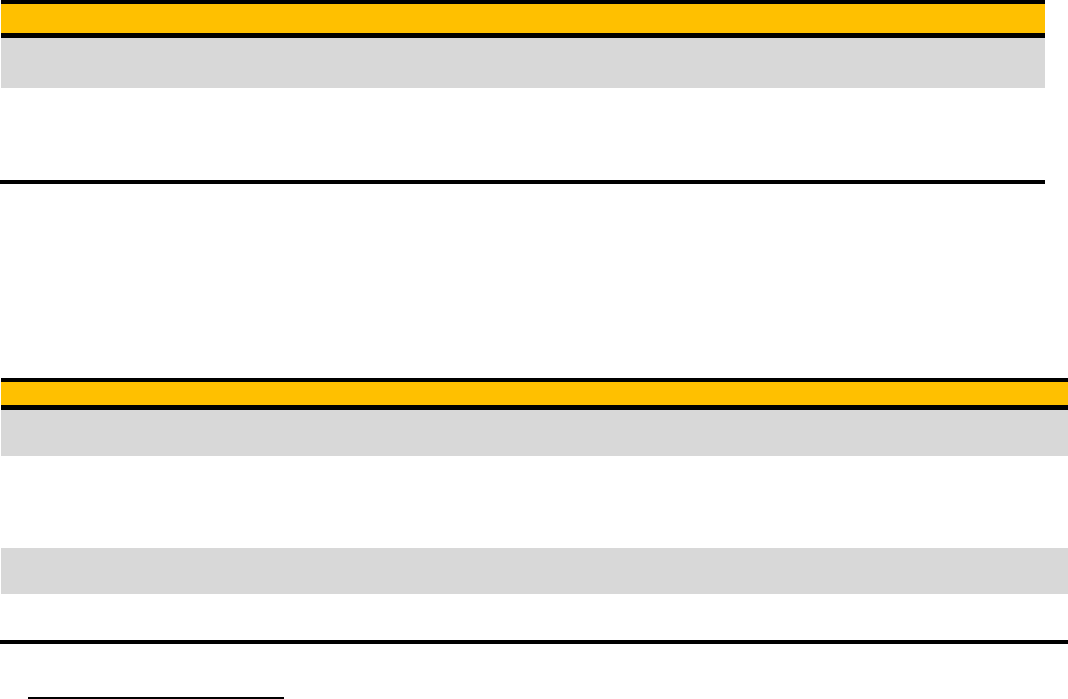
JAN 2023
21
Table 8: Pillar Prep Overview
Component
Muscles/Movements
Volume
Focus
Soft Tissue
2-4 muscles
≤30seconds
Release muscle tensions and
adhesions
Positional
Activation
(Mobility &
Stability)
2-4 movements
5-10 repetitions with 2-
second holds
Restore symmetry and control by
establishing an increased range of
motion
c. Movement Prep: The movement prep component of the warm-up is designed to
increase core temperature, activate and elongates muscles, enhance movement pattern
quality, and activate the central nervous system. Table 9 displays the components of
movement prep to include movements, volume, and focus.
Table 9: Movement Prep Overview
Component
Movements
Volume
Focus
Example
Dynamic Activation
2-4
6-15 repetitions
1-2 sets
Activating muscle
synergies
Glute bridge
Dynamic Flexibility
4-8
4-6 repetitions
1-2 sets
Actively increase 3-
dimensional elongation
through movement
patterns
Knee hug
Movement Integration
4-6
10-15 yards
1-2 sets
Engrain movement
patterns
Lunge with rotation
Neural Activation
4-6
5-15 seconds
1-2 sets
Prime the nervous system
for full speed activity
Quick feet
3. Pre-planned PT session. This PT session can include plyometric-SAQ, strength
training, and ESD. Pre-planned PT sessions should be sequenced based on the
intensity and neurological demand. When performed, plyometric-SAQ exercises should
be performed first
a. Plyometric-SAQ.
(1) Plyometric exercises involve quick, explosive movements to enable a muscle
to reach maximal force in a short time. Incorporating plyometric exercise can increase
power of subsequent movements and overall speed-strength qualities. Plyometric
exercise can assist in the development of power and speed, increasing the ability to
recruit muscle fibers efficiently and decreasing risk of injury. When incorporated into a
command PT session, they should be performed after movement prep and before the
strength session.
(2) When performing plyometric exercises, ensure proper warm-up (i.e., pillar
and movement prep), emphasizing proper technique during movement integration and
neural activation. Sailors should maintain proper form and alignment at all times,
landing softly to absorb shock. Between plyometric sessions, allow up to 72 hours for
recovery. The focus is on QUALITY, not quantity.
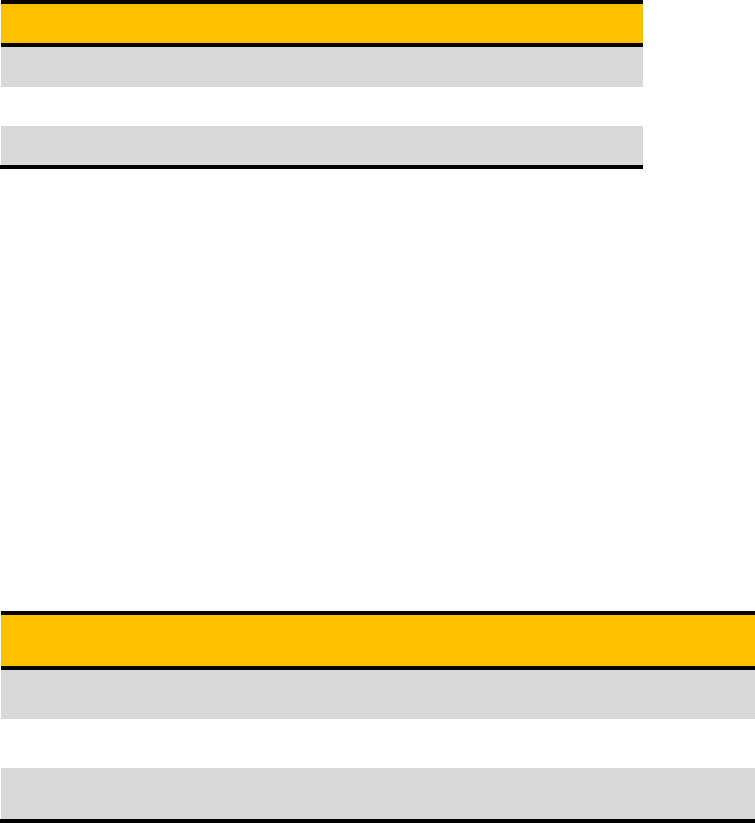
JAN 2023
22
(3) The recommended plyometric volume is based on contacts (i.e., foot contacts
with floor or box). Table 10 provides the recommended volume of plyometric exercise
based on experience.
Table 10: Plyometric Exercise Recommendations
Plyometric Experience
Volume
Beginner (no experience)
80-100
Intermediate
100-120
Advanced
120-140
(4) SAQ.
(a) Speed: Ability to move the body as quick as possible
(b) Agility: Ability to change direction quickly and effectively
(c) Quickness: Ability of the body to produce reflexive reactions
a. Strength Training
(1) Sailors need to strengthen muscles needed to perform on an operational
platform. They should pay close attention to the quality of movement patterns and
select a challenging resistance. Table 11 depicts the sets, repetitions, and rest for
improving muscular endurance, strength, and/or power.
Table 11: Strength Training Recommendations
Goal
Sets
Reps
Rest
Endurance
3-6
12
30 seconds
Strength
3-5
6
2-5 minutes
Power
3-5
1-5
2-5 minutes
(2) The order of exercises is significant in preventing injury and capitalizing on
muscle capabilities.
(a) Exercises should be sequenced based on the intensity and neurological
demand. Power exercises (e.g., power clean) should be the first exercises performed
during strength training sessions as they require high skill and concentration.
(b) Max strength and strength endurance exercises (e.g., bench press, squat,
and push press) follow power exercises as they are core exercises that generally
involve multiple joints and muscles groups.

JAN 2023
23
(c) Auxiliary exercises are the last exercises performed during a strength
session. Auxiliary exercises are generally single-joint exercises (e.g., bicep curls, tricep
curls).
b. Cardiorespiratory Exercise (Energy System Development)
(1) Metabolic Circuit: Metabolic circuits combine interval training principles with
resistance training into ESD. These circuits boost fat utilization by maximizing caloric
burn through multiple joints and muscle exercises with little rest between exercises.
Metabolic circuits include traditional cardiorespiratory exercises (e.g., jogging), strength,
endurance, explosiveness, mobility, agility, and power exercises.
(2) Linear Accelerations: Accelerations include sprint pattern drills to improve
sprint and movement speed. Accelerations can be performed using the cone drills,
linear accelerations, and box drills.
(3) Long Slow Distance (LSD). LSD includes running slowly or running for a set
amount of time or distance without regard to time.
(4) Pace/Tempo Training. Pace/Tempo training is cardiorespiratory training at an
intensity slightly higher than race pace. This can be accomplished by setting the
treadmill at the desired PRT speed, focusing on increasing duration at that speed. The
benefits include improved race pace and running economy (form).
(5) Fartlek Training. This term is Swedish for "speed play." A less structured
approach to interval training comprised of speed and fun. The session may be made up
as you go, to include jogging, running, and sprints.
4. Regeneration (Cool-down, Stretching, Recovery). A critical component of any
training program is regeneration. It brings balance back to the body, helping to relieve
tension and associated aches and pains while enhancing the body's response to the
training. Regeneration activities will help relieve aches, pains, inflammation, and
muscle tension while improving flexibility and tissue quality. Regeneration activities will
help after training sessions, keeping the body healthy and balanced. Regeneration
components of a training session include:
a. Cool-down. The cool-down period's purpose is to gradually lower the heart rate
and respiratory rate to pre-activity levels. Eliminating the cool-down (dropping to the
deck after cardio) can cause blood to pool in the lower extremities decreasing the
body's ability to return blood to the heart and brain. This can cause an irregular
heartbeat, dizziness, nausea, and fainting. Use the last 3 to 5 minutes of the workout
for a cool-down followed by stretching.
b. Stretching. Stretching sessions should focus on muscles utilized during the
training session to increase joint range of motion, decrease injury risk, improve
JAN 2023
24
performance, and aid in post-workout recovery. Static and Active Isolated Stretch
exercises can be found in Appendix B.
JAN 2023
25
APPENDIX A
_____________________________
PRE-PHYSICAL ACTIVITY
QUESTIONS FOR
COMMAND/UNIT PT AND FEP
JAN 2023
26
Pre-Physical Activity Questions
(1) Do you have a current PHA? If no, you are prohibited from participation today.
(2) Do you have chest pain (with or without exertion), bone or joint pain, high blood
pressure or high cholesterol? If yes, have you been cleared by your medical provider to
participate in PT?
(3) Do you have Sickle Cell Trait (SCT)? If yes, have you been cleared by your
medical provider to participate in PT? If not, you are prohibited from participation
today.
(4) Have you had a change in your medical status since the last time you were
asked these questions? If yes, have you been cleared by your medical provide to
participate in PT? If not, you are prohibited from participation today.
(5) Are you ill today or know of any medical condition that may prevent you from
participating in physical activity today? If yes, have you been cleared by your medical
provide to participate in PT? If not, you are prohibited from participation today.
JAN 2023
27
APPENDIX B
_____________________________
COMMAND PT REGENERATION

28
Static and Active Isolated Stretching (AIS) Protocol and
Recommendations
Static Stretching protocol:
1. When applying a stretch, make sure the body is in balance.
2. Slowly lean into the stretch.
3. Stretch to mild discomfort; the stretch should not hurt. Do not bounce while
stretching.
4. Aim to relax into the stretch as you breathe out.
AIS Protocol:
1. Start with the muscle in a relaxed state.
2. Actively move through the range of motion (ROM) without assistance.
3. Apply no greater than one pound of pressure at the end of the ROM.
4. Provide a controlled return back to starting position.
5. The stretch should be no longer than 2 seconds.
6. Repeat the stretch 10 times, with each stretch attempting to increase ROM.
7. Always return the muscle being stretched back to the starting position.
8. Exhale during the stretch and inhale during relaxation.
Additional regeneration exercises can be found at
https://www.navyfitness.org/fitness/noffs-training/noffs-series/regeneration-strategies
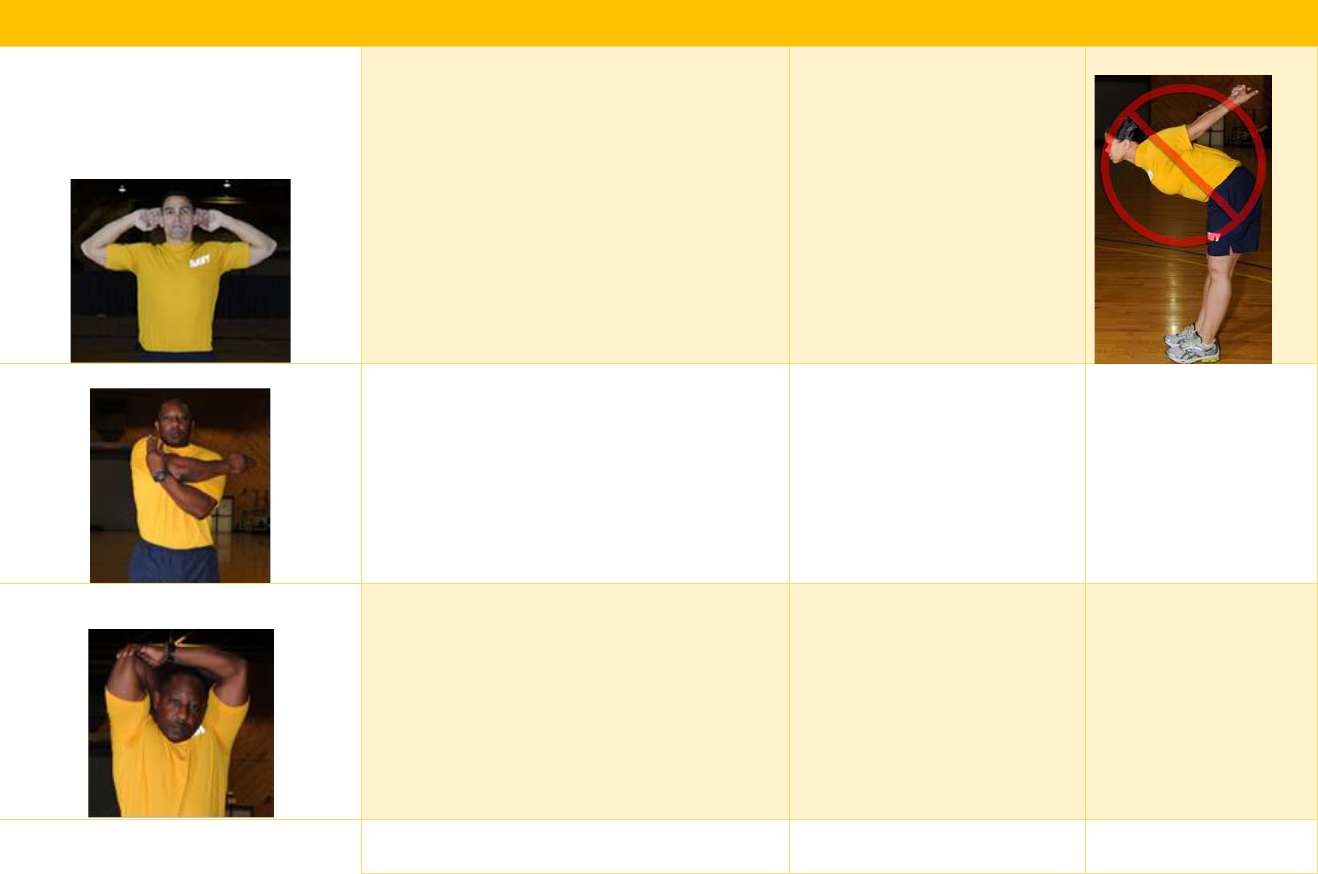
29
Recommended Static Stretches
Stretch
Description & Caution
Recommended for
Movement
Contraindicated
Stretch
Chest Stretch
Description: In a standing position, gently
clasp both of your hands and place them on
the back of your neck. Slowly pull your
elbows back until you feel a stretch on your
chest. Do not pull your head forward or place
tension on the neck
Caution: You can do this as a partner
assisted stretch but they should not force the
stretch by aggressively pulling back on the
elbows.
Horizontal Push (e.g., push-
up, chest press)
Posterior Shoulder Stretch
Description: Place your left hand on the back
side of your right arm above your elbow on
the front of your body and gently pull your
arm across your body. You should feel a
stretch on back side of your shoulder and
upper arm. Repeat to stretch opposite side of
your body.
Horizontal or Vertical Pull
(e.g., bent over row, pull up)
Triceps Stretch
Description: Take your left arm and reach
behind your back. By placing your right hand
on the back side of your left arm, gently push
back to achieve a stretch on the left triceps
muscle. Repeat on opposite side.
Horizontal or Vertical Push
(e.g., bench press, overhead
press)
Hip Flexor Stretch
Description: In a standing position, place your
right foot approximately 3 to 4 feet in front of
Lower Body Push (e.g., back
squat, walking lunges)
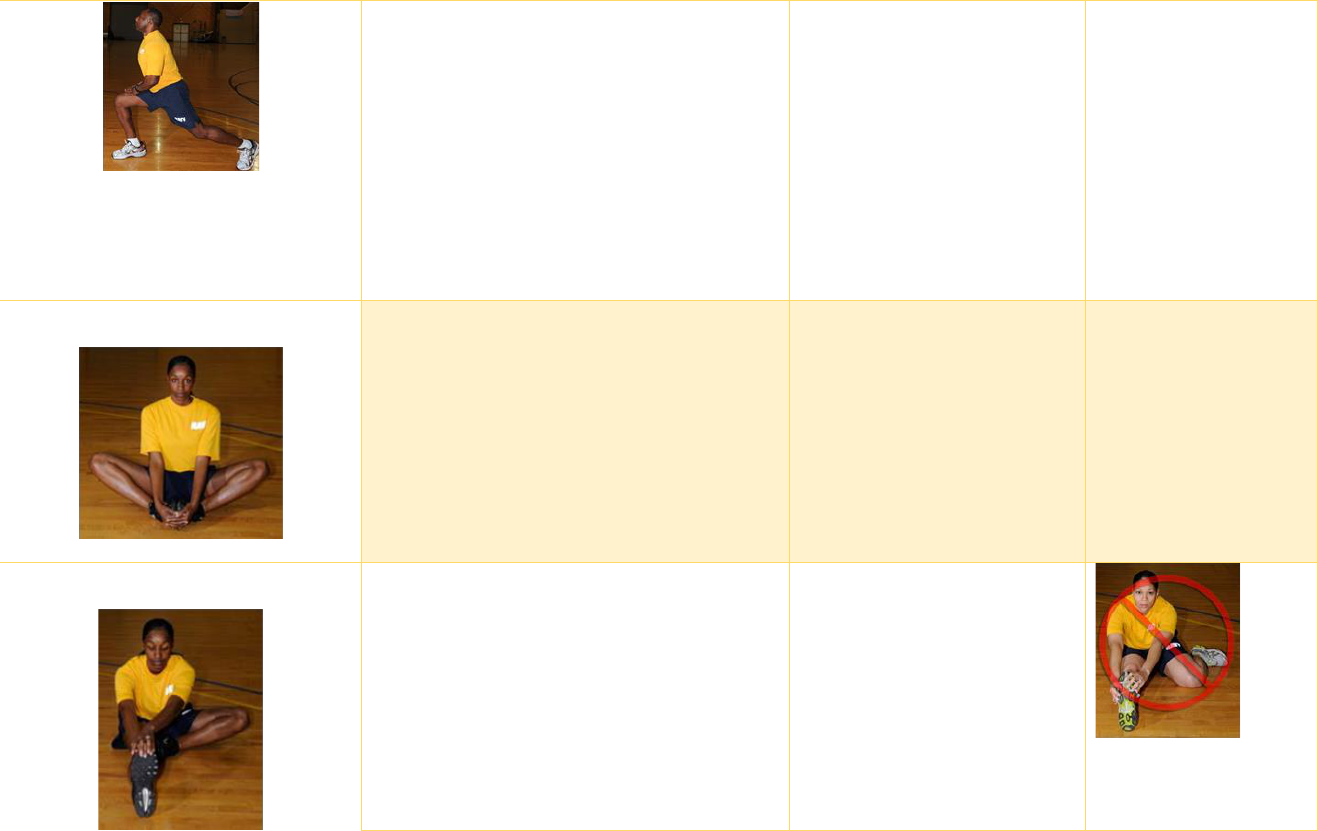
JAN 2023
30
your left foot (like a lunge). Slowly bend both
knees until you lower your body towards the
ground. Your left knee should almost be at 90
degrees. Gently push your left hip forward to
feel the stretch in the front of your hip. If you
don't feel the stretch, gently lean your upper
body back.
Tip: Since you use this muscle group during
the Navy Curl-Up, this stretch should be
performed after the curl-up event to prevent
cramping and prepare this muscle group for
the cardio event
Groin or Butterfly Stretch
Description: While sitting with the upper body
nearly vertical and legs straight, bend both
knees, and bring the soles of the feet
together. Pull feet toward your body. Gently
place your hands on your feet and your
elbows on your knees. Pull your upper body
slightly forward as your elbows push down.
You should feel a stretch in your groin area.
Lower Body Push or Pull (e.g.,
lateral lunge, single-leg RDL)
Modified Hurdler Stretch
Description: While sitting in a v-position,
gently pull your left foot towards your groin
area. Your right leg will remain straight with a
slight bend in the knee. Gently lean forward
and reach for your toes on your right leg to
stretch out your hamstring.
Note: The stretch will be more difficult if you
try to perform the hamstring stretch if you pull
your toes back towards your body (vs.
pointed).
Lower Body Push or Pull (e.g.,
deadlift, RDL, squat)
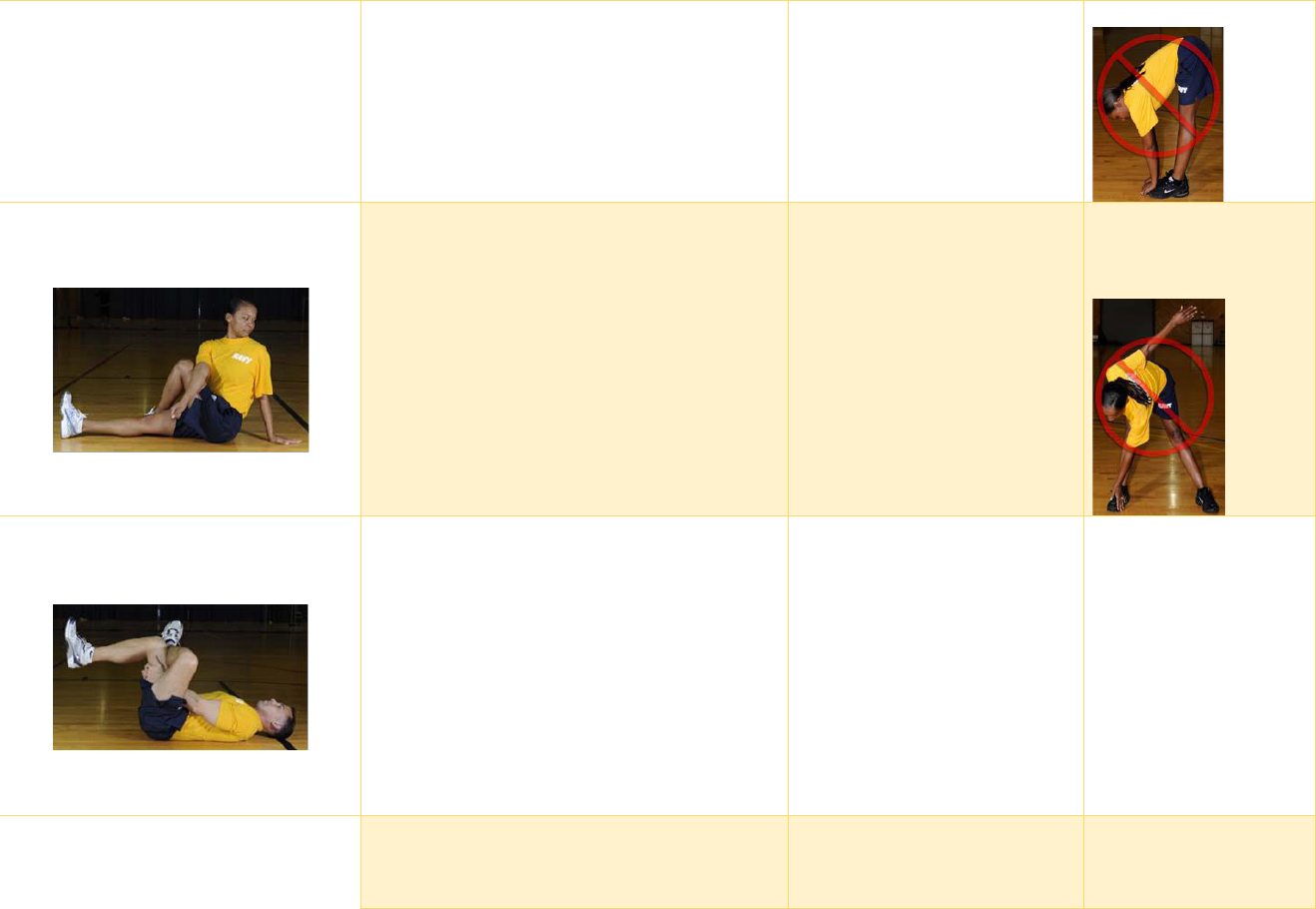
JAN 2023
31
Outer-Hip-and-Low-Back-Stretch
Description: While in a long sitting position
(legs in front of you with knees straight),
cross your right leg over the left. Your right
foot should be on the ground at
approximately your left knee level. Take your
left elbow and place it on the outside of your
right knee and gently push your knee towards
the left side of your body. You should feel a
stretch on the outer portion of your right hip
and in your low and mid back region. Repeat
to opposite side.
Lower Body Push or Pull (e.g.,
deadlift, squat, lateral lunge,
RDL)
Avoid spinal rotations,
they are bad for the
back
Piriformis Stretch
Description: While you are lying on your back,
gently cross your right leg over your left thigh
(both knees are bent at 90 degrees). Take
both hands and place on the back side of
your left thigh. Gently pull towards your chest
until your feel slight tension in your right
buttock and outer thigh. Repeat on opposite
side.
Note: If you are experiencing low back pain
after performing physical activity, seek
medical assistance. This exercise should be
performed to increase flexibility in this region
and may assist in decreasing pain.
Lower Body Push or Pull (e.g.,
deadlift, squat, lunge, RDL)
Low Back Stretch
Description: While lying on your back, gently
pull one or both knees to your chest. You
should feel a stretch in your low back and
buttocks.
Lower Body Push or Pull (e.g.,
deadlift, squat lunge, RDL)
Avoid extreme
hyperextension of the
spine (arching the
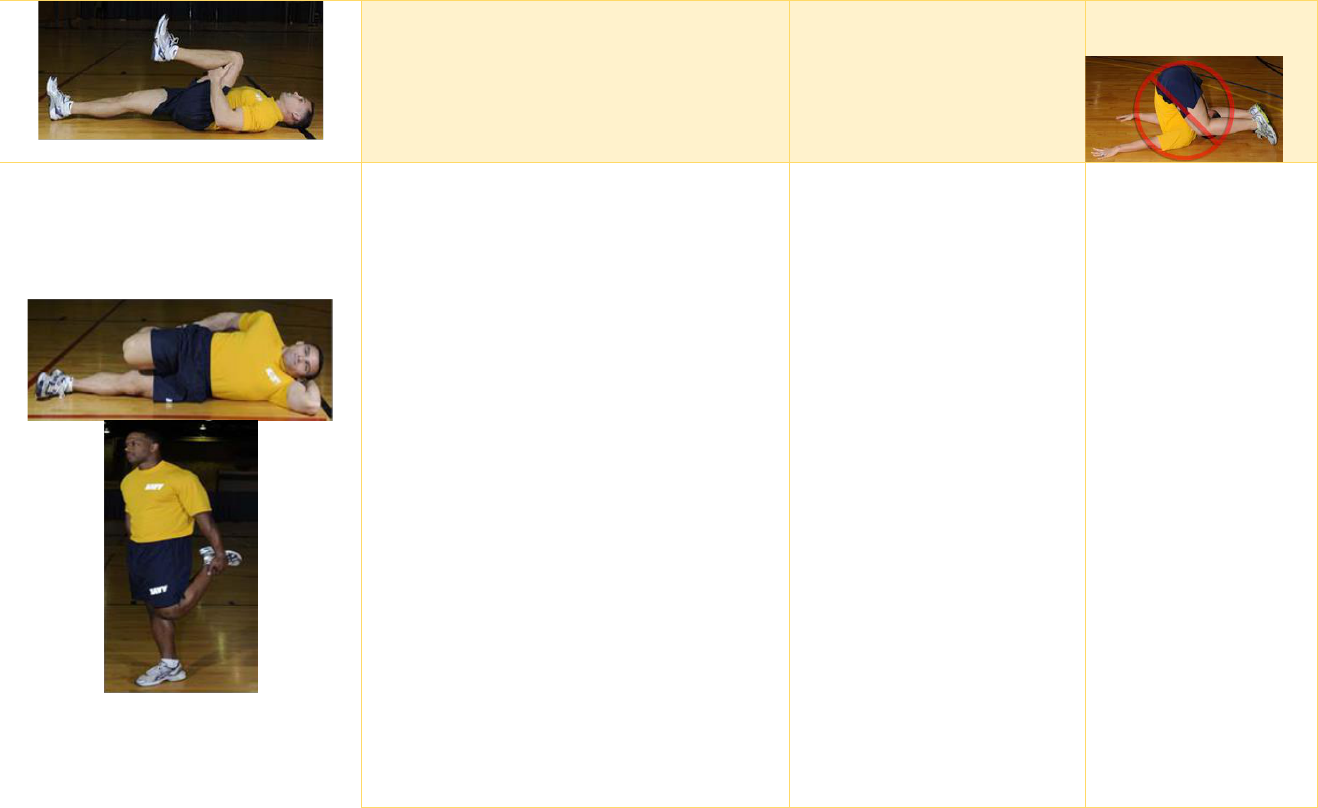
JAN 2023
32
back).
Quadriceps Stretch
On-the-Ground Description: While lying on
your side, with a slight bend in your left knee,
grabs your right ankle with your right hand
and maintains your balance. Gently pull your
right foot towards your buttocks while making
sure your knees is aligned with the body
(make sure knee is not sticking out and it is
directly below your hip. Repeat to opposite
side.
Standing Description: In a standing position,
with a slight bend in your left knee, grab your
right ankle with your right hand and maintain
your balance. Gently pull your right foot
towards your buttocks while making sure your
knees is aligned with the body (make sure
knee is not sticking out and it is directly below
your hip). You can also stretch out your
trapezius (neck) muscles during this
quadriceps stretch (neck muscles) by
bringing your chin to the opposite side of your
chest. Repeat to opposite side.
Note: If you are having difficulty balancing
you can hold on to a wall or perform this
stretch while lying on your side.
Lower Body Push (e.g., squat,
lunge)
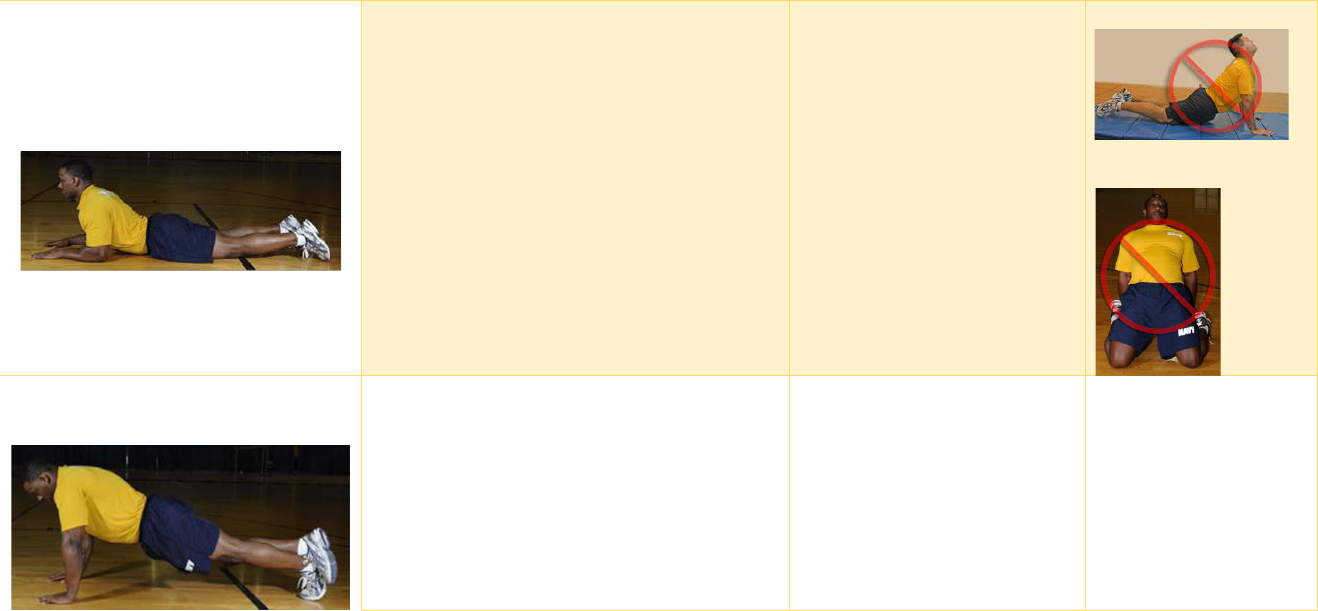
JAN 2023
33
Abdominal Stretch
Description: On your stomach, place your
hands beneath your shoulder and gently push
up until you feel a stretch on your abdominal
muscles. Do not fully lock out your elbows
and hyperextend your back.
Note: If you feel any discomfort in your low
back while performing this exercise, you can
reduce the tension by using the "propped on
elbow" position.
Core
Calf Stretch
Description: In a push-up position, cross the
left foot over the right. With the right knee
straight, gently push the right heel toward the
deck. You will feel a stretch in the right calf.
Hold for 15 seconds. Repeat to opposite side.
Note: Your body should remain in a straight
line from your shoulders to your ankle to
prevent low back injury and to strengthen
your core muscles.
Plyometrics (e.g., jumping,
bounding), ESD (e.g., running)
JAN 2023
34
APPENDIX C
_____________________________
CONTRAINDICATED/HIGH-RISK EXERCISES AND
STRETCHES
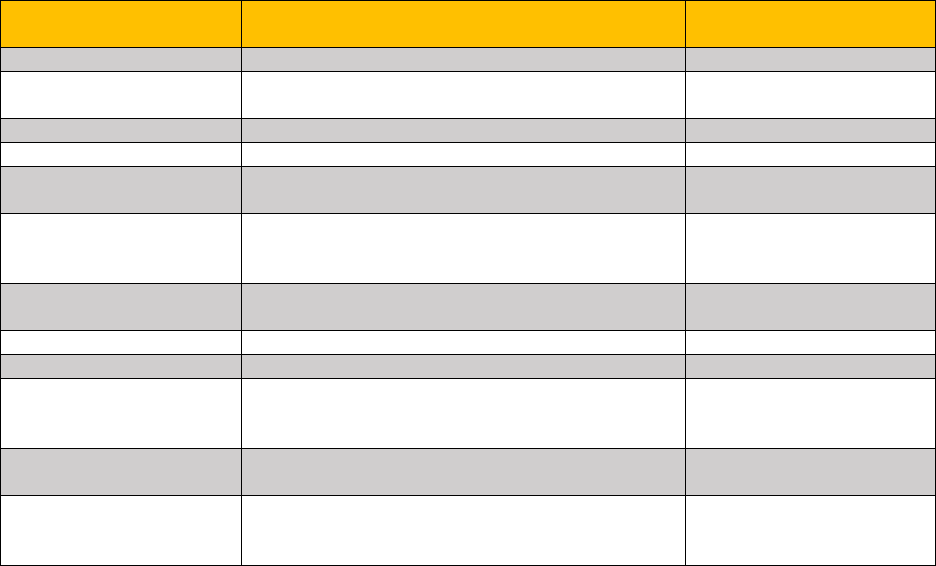
JAN 2023
35
Contraindicated/High-Risk Exercises
Contraindicated
Exercises
Rationale
Alternative Exercise
Burpees
Extension in the spine
Donkey Kicks
Places excessive pressure, hyperextension of
low back
Glute Bridge
Deep Knee Bends
Overstretches ligaments of the knee
Reverse Lunges
Deep Knee Lunges
Places excessive pressure on the forward knee
Reverse Lunges
Windmill
Places a tremendous amount of stress on the
low back and supporting muscles
Toe Tap to the Front /
Toe Tap to the Rear
Cherry Pickers
Places excessive pressure on the low back and
supporting muscles
Bicep Curls
Knee Blocks
Steam Engines
Flutter Kicks
Place excessive pressure on low back and/or
cervical spine
Bicycles/ Plank/Isometric
hold
Hello Dollies
Places excessive pressure on the low back
Bicycles/Plank
Jack Knives
Places excessive pressure on the low back
Bicycles/Plank
8-Count Bodybuilders
Can lead to increased compression of the
spine, potentially leading to stress fractures
and/or muscles strains
Plank/Side Bridges/
Alternating Superman
Mountain Climbers
Increased compression of the spine during
rotation.
Plank / Side Bridges
Ballistic Wood Chops
Incorporates ballistic/bouncing movements
which are considered a contraindicated
movement
Knee Blocks/Steam
Engines/Standing Side
Crunch
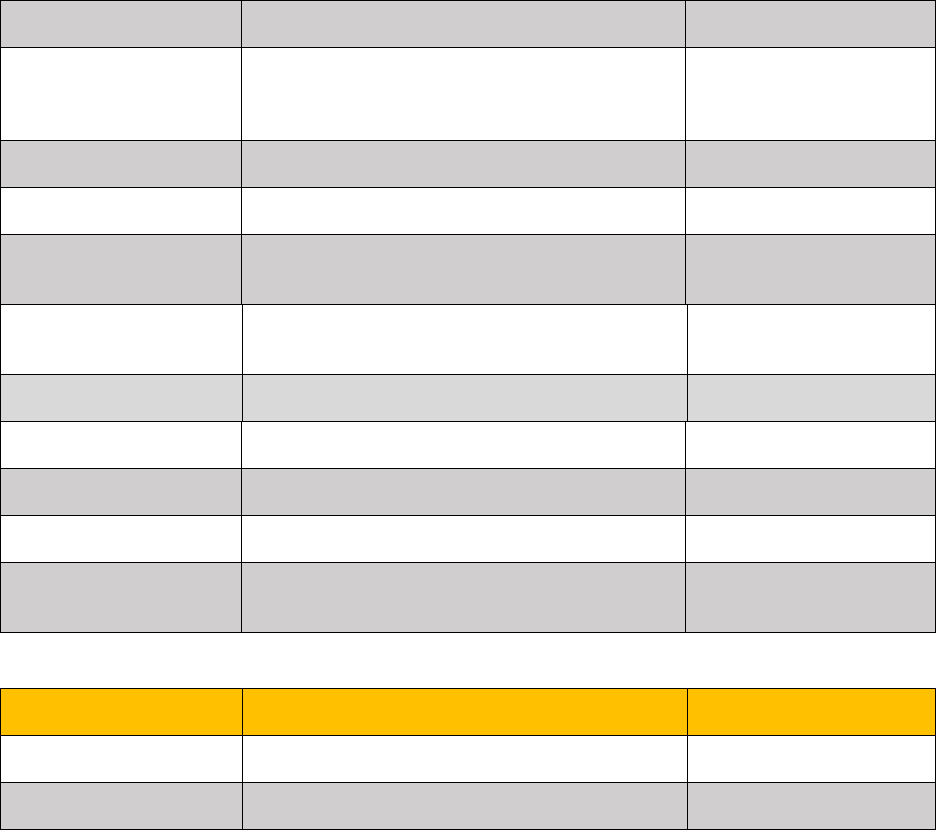
JAN 2023
36
Star Bursts
Ballistic movement
Jumping Jacks/
Plyo-Jacks
Simultaneous arm and
leg lifts on stomach or
swimmers
Hyperextends the back and places pressure on
spine
Alternate opposite arm,
opposite leg/ Bird dog
(alternate on hands and
knees)
Hurdler's Stretch
Places excessive pressure on flexed knee joint
Modified Hurdler's
Stretch
Standing Hamstring
Stretch
Places excessive pressure on the low back
Modified Hurdler's
Stretch
Quadriceps Stretch
(sitting on knees) and
lying back
Places excessive pressure on both knee joints
Standing Quadriceps
Stretch / Lying
Quadriceps Stretch
Swimmer's Arm Stretch
(clasp hands behind
back and lift)
Could lead to shoulder instability and
predisposition to injury as well as places
excessive pressure on low back
Standing Chest Stretch
(using a doorway)
Lumbar Rolls
Can over compress the lumbar intervertebral
disks
Toe Tap to the front/ Toe
Tap to the rear
Sit and Reach
(Hamstring)
Places excessive pressure on low back
Modified Hurdler's
Stretch
Standing Toe Touch
Extreme unsupported lumbar flexion, increases
pressure on back and small muscles
Yoga Plow
Places excessive pressure on cervical
intervertebral disks
Superman (alternating
arms)
Neck Hyperextension
and Neck Rolls
Can pinch anterior cervical nerves and over
compress cervical intervertebral disks
Gently lower your chin to
your chest (Do not
perform neck circles)
Contraindicated
Stretches
Rationale
Alternative Exercise
Chest Fling Backs
Involves ballistic, controlled movements
Standing Chest Stretch
(using a doorway)
Wide Circle Sun Gods
Overstretches ligaments of the shoulder and
could possibly damage shoulder cartilage
Pec Fly w/Overhead
Raise
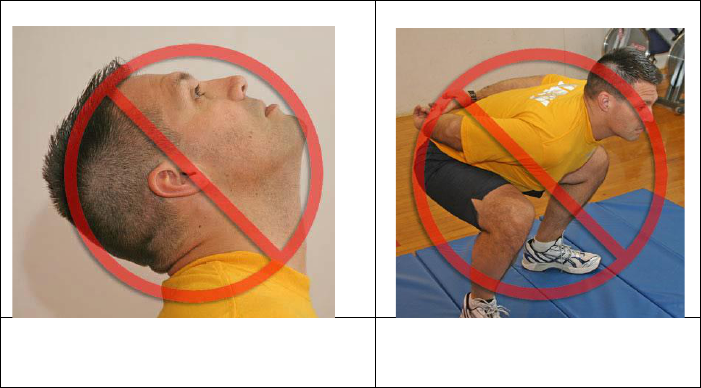
JAN 2023
37
Contraindicated/High-Risk Stretches
It is best to completely avoid contraindicated positions or stretches. Although it is not guaranteed that an injury will result,
the chances are significantly increased. There are safe and effective alternatives to contraindicated stretches. Even if you
do not feel pain while performing a contraindicated stretch, damage may occur, which may show up later.
This stretch may cause an
individual to get dizzy
(extreme hyperextension)
Deep squats that compromise
form (e.g., neutral spine)
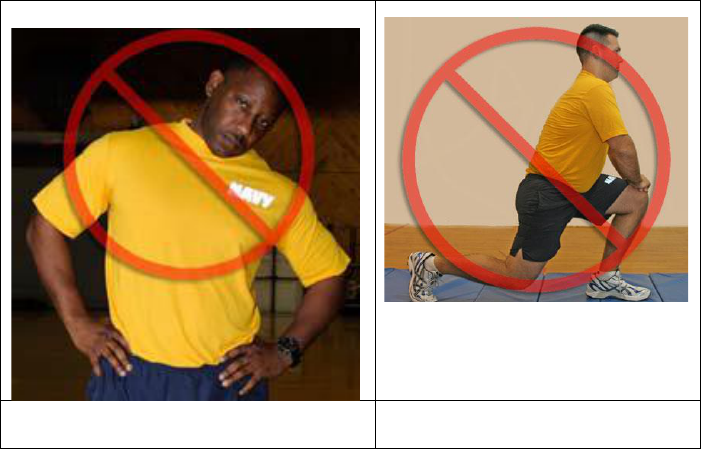
JAN 2023
38
Do not perform circular motions.
Avoid the knee extending to far
beyond the toes
39
APPENDIX D
_____________________________
SAMPLE WORKOUTS
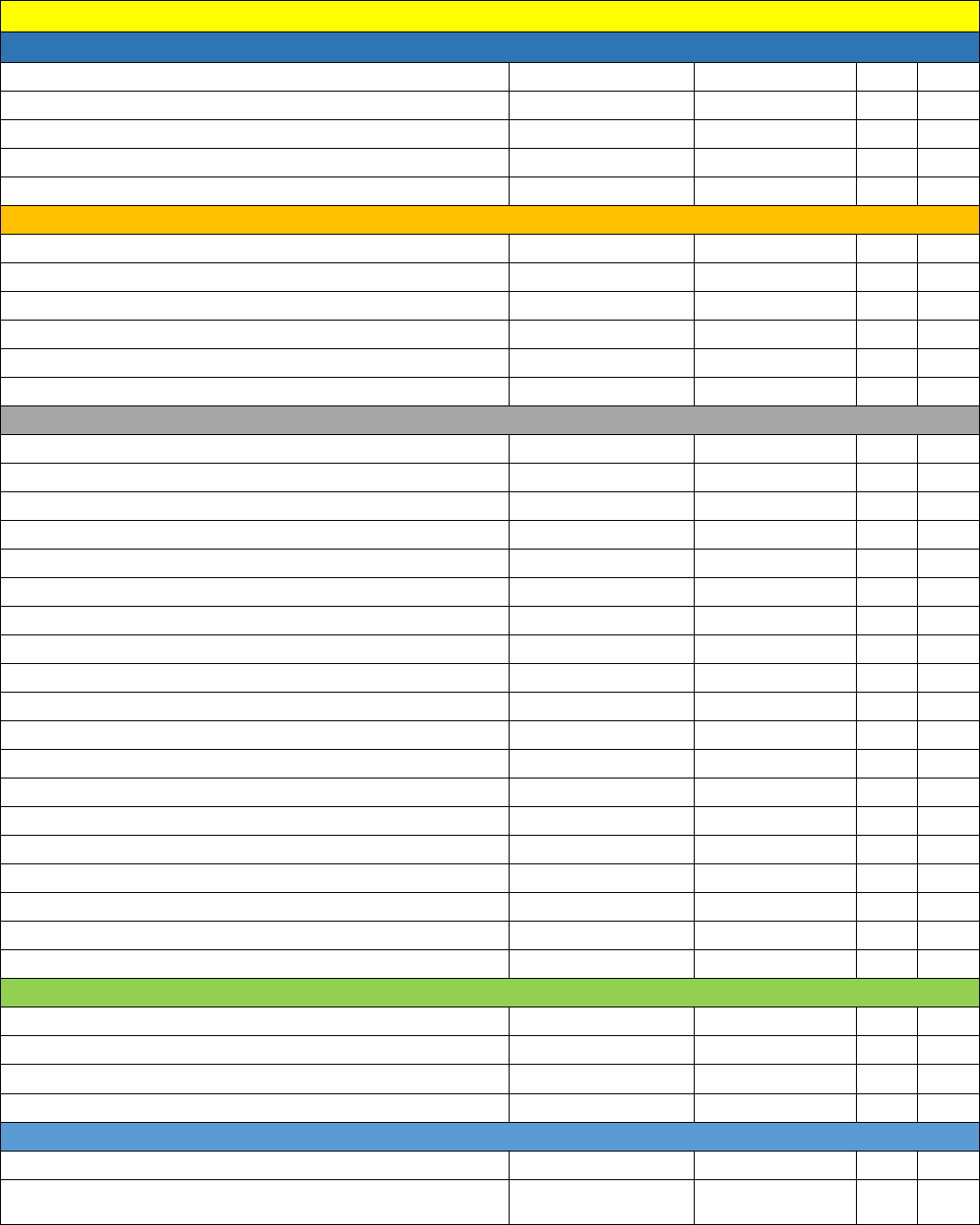
JAN 2023
40
Operational Workout
Pillar Prep
Exercise
Reps
Tempo
Sets
Rest
90/90 with Arm Sweep
4/Each
3:3
1
-----
Glute Bridge with Leg Lock
4/Each
2:2
1
-----
Pillar Bridge with Hip Flexion
4/Each
2:2
1
-----
Bent Over "W"
8
3:3
1
-----
Movement Prep
Exercise
Reps
Tempo
Sets
Rest
Banded Lateral Walks - Band Above Knees
15 Yds/Each
-----
1
-----
Reverse Lunge with Rotation
4/Each
-----
1
-----
Inverted Hamstring
4/Each
3:3
1
-----
Bent Over "T" with Band
8
3:3
1
-----
Drop to Base Pogo
3-5 Sec
-----
2
-----
Strength
Circuit 1
Reps
Tempo
Sets
Rest
Rear Foot Elevated Split Squat - Loaded/Unloaded
10-12
3:3
2
-----
Med Ball Underhand Toss
10-12
-----
2
-----
1/2 Kneeling Single Arm Press
10-12
2:2
2
-----
Farmers Walk
20-30 Yds
-----
2
-----
Deadbug
10-12
3:3
2
1:00
Circuit 2
Deadlift
10-12
3:3
2
-----
Lateral Goblet Squat – Alternating
10-12
3:3
2
-----
Inverted Row
10-12
2:2
2
-----
Single Arm Bench Press
10-12
2:2
2
-----
Bird Dog
10-12
3:3
2
1:00
Circuit 3
Pillar Bridge with Lateral Pull Through
10-12
-----
1
-----
Bicep Curl to Overhead Press
10-12
2:2
1
-----
1/2 Kneeling Rotation Slam with Med Ball
10-12
-----
1
-----
Leg Curl - Sliders or Stability Ball
10-12
3:3
1
-----
Lat Pull Down to Tricep Extension
10-12
2:2
1
-----
Toe Pull to Deep Squat
10-12
-----
1
-----
Energy System Development
Exercise
Reps
Tempo
Sets
Rest
Reaction Drills
1
-----
4
1:00
Linear Acceleration
1
-----
4
1:00
Cone Drills (6-Cone)
1
-----
4
1:00
Regeneration
Exercise
Required Time
Tempo
Sets
Rest
Total Body Stretch (See Appendix C recommended static
stretches)
8-10 Minutes
20 Sec/Each
1
-----
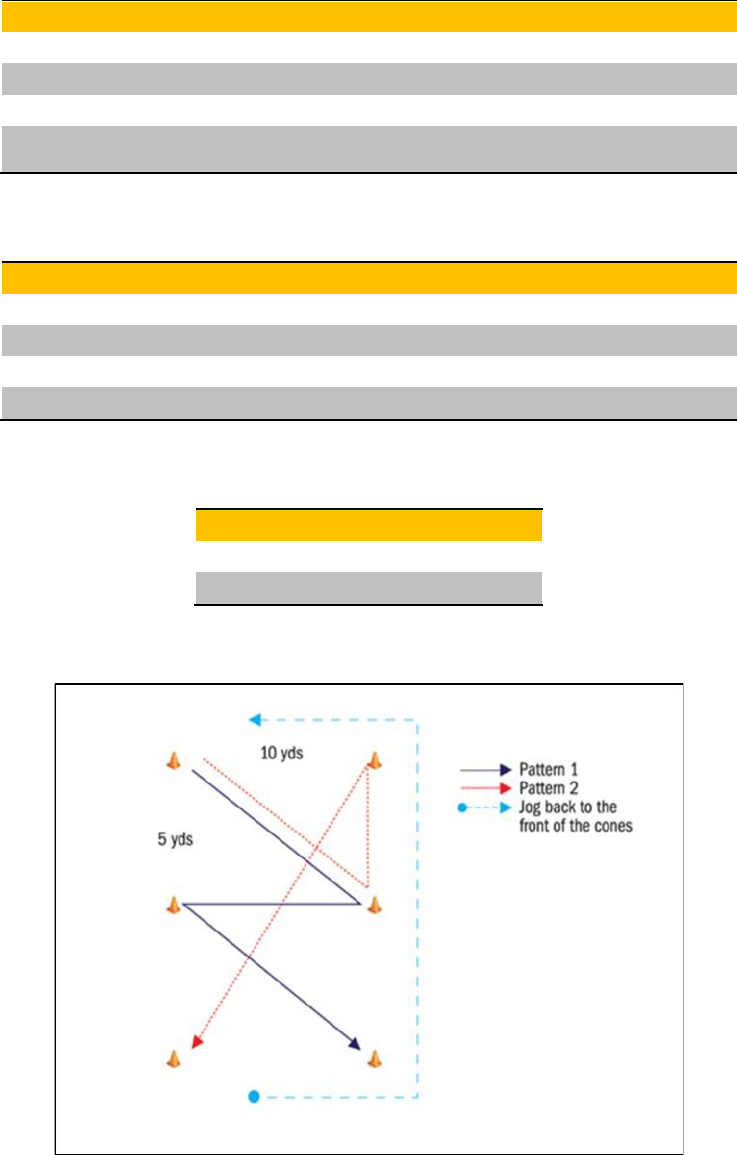
JAN 2023
41
Energy System Development
SAQ Drills (Get Up and Go) – 4 sets
Position
Distance
Reps
Rest
Face Down/Head Forward
20 YDs
1
1-min
On Back/Head Forward – Roll Left
20 YDs
1
1-min
On Back/Head Forward – Roll Right
20 YDs
1
1-min
Face Down/Head Forward – Push up
(x2)
20 YDs
1
1-min
Linear Acceleration – 4 sets
Intervals
Distance
Reps
Rest
20yds Easy – 20 yds moderate
40 YDs
1
1-min
20 yds Moderate – 20 yds Easy
40 YDs
1
1-min
10 yds Max – 30 yds Moderate
40 YDs
1
1-min
20 yds Max – 20 yds Moderate
40 YDs
1
1-min
Cone Drills (6-Cone) – 4 sets
Pattern
Reps
Rest
1
2
1-min
2
2
1-min

JAN 2023
42
Endurance Workout
Pillar Prep
Exercise
Reps
Tempo
Sets
Rest
90/90 Stretch
4/Each
3:3
1
-----
Glute Bridge Marching
4/Each
2:2
1
-----
Plank with Leg Lift
4/Each
2:2
1
-----
Plank Rolling
4/Each
3:3
1
-----
Bent Over "Y"
8
3:3
1
-----
Movement prep
Exercise
Reps
Tempo
Sets
Rest
Hip External Rotation with Bands
8/Each
3:3
1
-----
Banded Forward/Backward Walk - Bands Above Knees
15 Yds/Each
-----
1
-----
Inverted Hamstring to Leg Cradle
4/Each
3:3
1
-----
Reverse Lunge Elbow to Instep with Rotation
4/Each
-----
1
-----
Power Skip (Height)
15 Yds
-----
1
-----
Drop to Single Leg Balance to Base Pogo to 2 Inch Run
3-5 Sec
-----
2
-----
Plyos
Exercise
Reps
Tempo
Sets
Rest
Single Leg Line Hop: Medial/Lateral, Forward/Backward
6/Leg
-----
2
1:30
45 Degree Bound (Focus: Landing Stabilization)
6
-----
2
1:30
Drop Squat to Squat Jump (Focus: Landing Stabilization)
6
-----
2
1:30
Standing Broad Jump (Focus: Landing Stabilization)
6
-----
2
1:30
With Partner, Med Ball Power Chest Pass Lying Down
6
-----
2
1:30
With Partner, Lateral Rotational Power Med Ball Toss
6
-----
2
1:30
ESD
Exercise
Reps
Tempo
Sets
Rest
Row/Bike/Versa Climber (Machine-Based/Non-Impact)
200m or 30 Sec
RPE = 9/10
2
2:00
300 Yd Shuttle Run (25 Yds Down/Back)
1
RPE = 9/10
2
2:00
Regeneration
Exercise
Required Time
Tempo
Sets
Rest
Total Body Self Myofascial Release (NOFFS SES Series)
20 Minutes
30-40 Sec/Each
1
-----
Total Body Stretch (See Appendix C recommended static
stretches)
8-10 Minutes
20 Sec/Each
1
-----
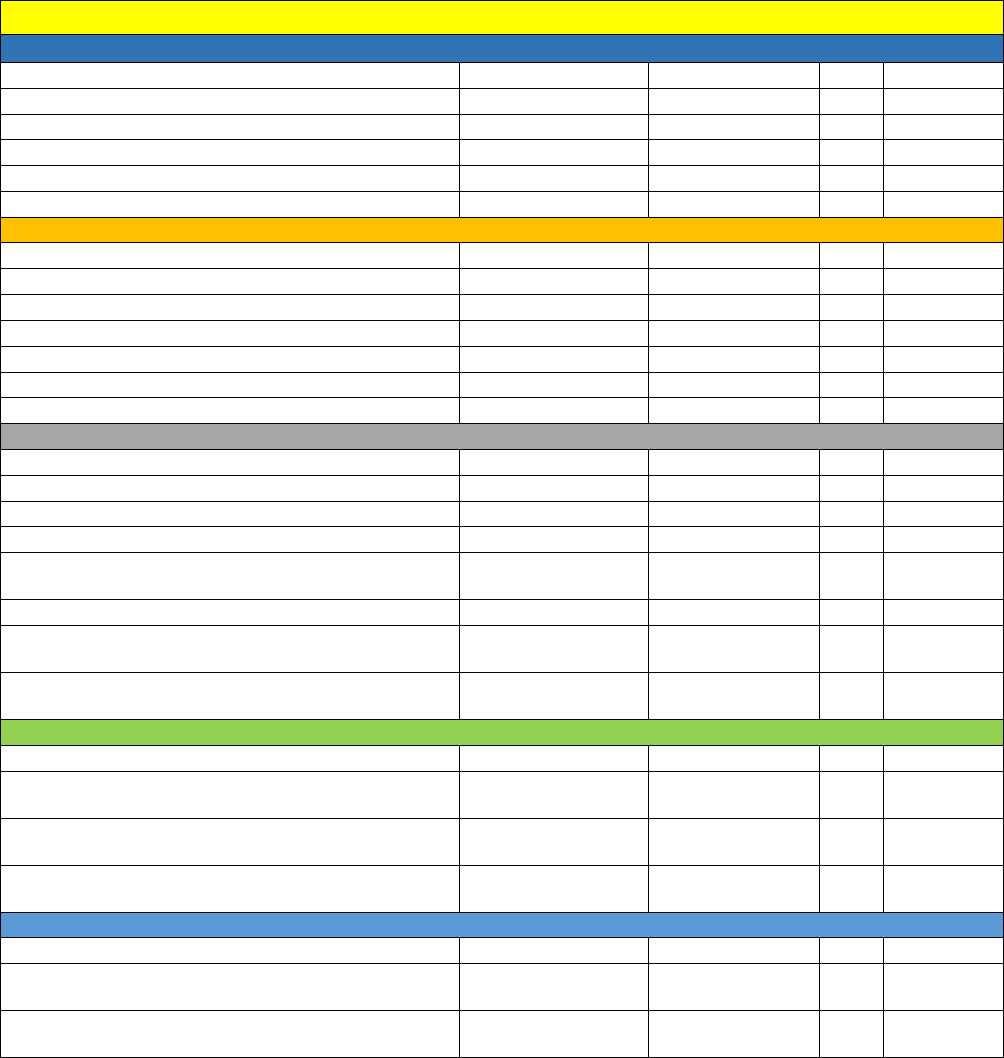
JAN 2023
43
Sandbag Workout
Pillar Prep
Exercise
Reps
Tempo
Sets
Rest
90/90 with Arm Sweep
4/Each
3:3
1
-----
Glute Bridge Marching
4/Each
2:2
1
-----
Quadruped Hip Circles
8/Each
2:2
1
-----
Lateral Pillar Bridge - Dynamic (Hip Touch)
8/Each
2:2
1
-----
Bent Over "T"
8
3:3
1
-----
Movement prep
Exercise
Reps
Tempo
Sets
Rest
Hip External Rotation with Bands
8/Each
3:3
1
-----
Reverse Lunge with Rotation
4/Each
-----
1
-----
Inverted Hamstring
4/Each
3:3
1
-----
Lateral Squat – Alternating
4/Each
-----
1
-----
Walking Pillar Bridge (Inch Worm)
4
-----
1
-----
Drop to 2 Inch Run
3-5 Sec
-----
2
-----
Strength
Exercise
Reps
Tempo
Sets
Rest
Squat to Over Head Press – Alternating
30 Sec
2:2
3
15 Sec
Single Arm Sandbag Carry
30 Sec
15 Sec/Arm
3
15 Sec
RDL to Bicep Curl
30 Sec
3:3
3
15 Sec
Rotational Lift - Sandbag Low (Knee Height) to
High
30 Sec
2:2
3
15 Sec
Bent Over Row
30 Sec
2:2
3
15 Sec
Supine Single Leg Lowering - Sandbag Hold
Over Chest
30 Sec
3:3
3
15 Sec
Push-Up - Staggered Hands (Option: Sandbag
on Back)
30 Sec
2:2
3
15 Sec
ESD
Exercise
Reps
Tempo
Sets
Rest
40 Yd - Sandbag (Across Shoulders) Walking
Lunges
20 Yds
Down/Back
RPE = 7/10
2
1:00
40 Yd - Sandbag Lateral Toss from Hip
20 Yds
Down/Back
RPE = 7/10
2
1:00
20 Yd - Bear Crawl with Forward Pull Through
10 Yds
Down/Back
RPE = 7/10
2
1:00
Regeneration
Exercise
Required Time
Tempo
Sets
Rest
Total Body Self Myofascial Release (NOFFS
SES Series)
20 Minutes
30-40 Sec/Each
1
-----
Total Body Stretch (See Appendix C
recommended static stretches)
8-10 Minutes
20 Sec/Each
1
-----
JAN 2023
44
APPENDIX E
_____________________________
IMPROVING PRT SCORES
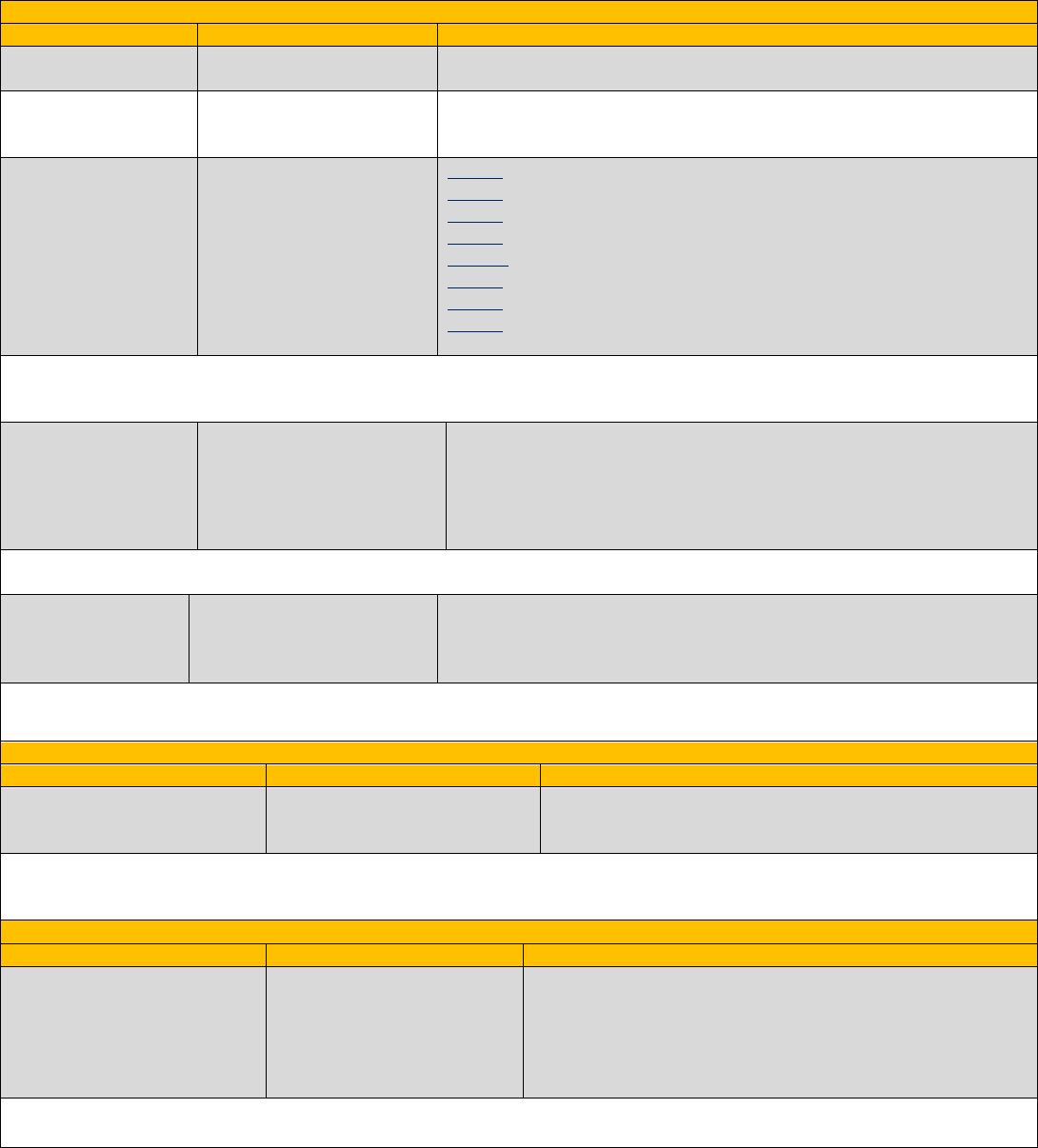
JAN 2023
45
Training Methods for Improving the 1.5 Mile Run
Training Method
Benefit
Example
Long Slow Distance
(LSD)
Builds aerobic base
3 mile or 30 min run at members own pace
Pace/Tempo
Train at and improve 1.5
mile race pace
To determine appropriate treadmill setting (mph), divide 90 by your
desired 1.5 mile run time. Ex: For a 12:30 run time, divide 90 by
12.5 which equates to 7.2 mph setting on the treadmill.
Interval Sample 1:
High Intensity
Cardio Circuit*
Improves aerobic power
and enhances anaerobic
metabolism
Step 1: Jumping Jacks for 30 sec
Step 2: Quick Feet/High Knees for 30 sec
Step 3: Cross Country Skiing for 30 sec
Step 4: Rest for 2 min
Step 5: Push-Ups for 30 sec
Step 6: Crunches for 30 sec
Step 7: Glute Bridge or Plank hold for 30 sec
Step 8: Rest for 2 min
Repeat 3 times
* As member progresses, periodically increase the allotted time for each event (e.g., from 30 sec to 45 sec), decrease
the amount of time for rest (e.g., from 2 min to 1 min), and/or increase the number of cycles completed (e.g., from 3 to 5
cycles).
Interval Sample 2:
"FEP for Five"
5 regular push-ups
5 crunches
Plank position (count up to 5 using a military four count)
Bridging (count up to 5 using a military four count)
Superman (alternating arm with leg, not at same time)
Perform each exercise for 5 repetitions using a military four count. As member progresses, periodically increase the
number of repetitions (e.g., 3 to 5) and/or the cycles completed (e.g., from 2 to 3).
Repetition
Improves running speed,
running economy (form),
and anaerobic metabolism
Sprint 50 yards* at 50-60% max intensity
Sprint 50 yards* at 60-70% max intensity
Sprint 50 yards* at 70-80% max intensity Sprint 50 yards* at 80-
100% max intensity
* As member progresses, periodically increase the sprint distance (e.g., from 50 to 75 yards) and/or increase the number
of cycles completed (e.g., from 3 to 5).
Training Methods for Improving Push-ups
Training Method
Benefit
Example
Upper-body Strength
Training
Improves upper-body
strength and endurance
Bench Press* (1-3 sets of 8-12 reps)
Shoulder Press* (1-3 sets of 8-12 reps)
Tricep Extension* (1-3 sets of 8-12 reps)
* The amount of weight is determined by how many reps the member is able to complete using proper form. Optimal
reps: 8-12. If the member is able to perform 12 or more reps, increase the weight in 5 pounds increments. If the
member is only able to perform 8 or fewer reps, decrease the weight in 5 pound increments.
Training Methods for Improving Forearm Plank
Training Method
Benefit
Example
Core Strength Training
Improves abdominal, low
back, and shoulder strength
and endurance
Russian Twists* (2 sets of 15-25 reps)
Pillar Bridge with Alternating Arm Lift* (2 sets of 8-12 on
each side)
Dynamic Lateral Pillar Bridge (R & L; 8-12 reps each side)
Bicycle Crunch* (2 sets of 15-25 reps)
Glute Bridge Marching* (2 sets of 8-12 reps)
* As member progresses, periodically increase the number of sets performed (e.g., from 2 to 3) and/or the allotted
amount of time (e.g., from 30 sec to 45 sec).
JAN 2023
46
APPENDIX F
___________________________
FEP MONTHLY TRACKING LOG
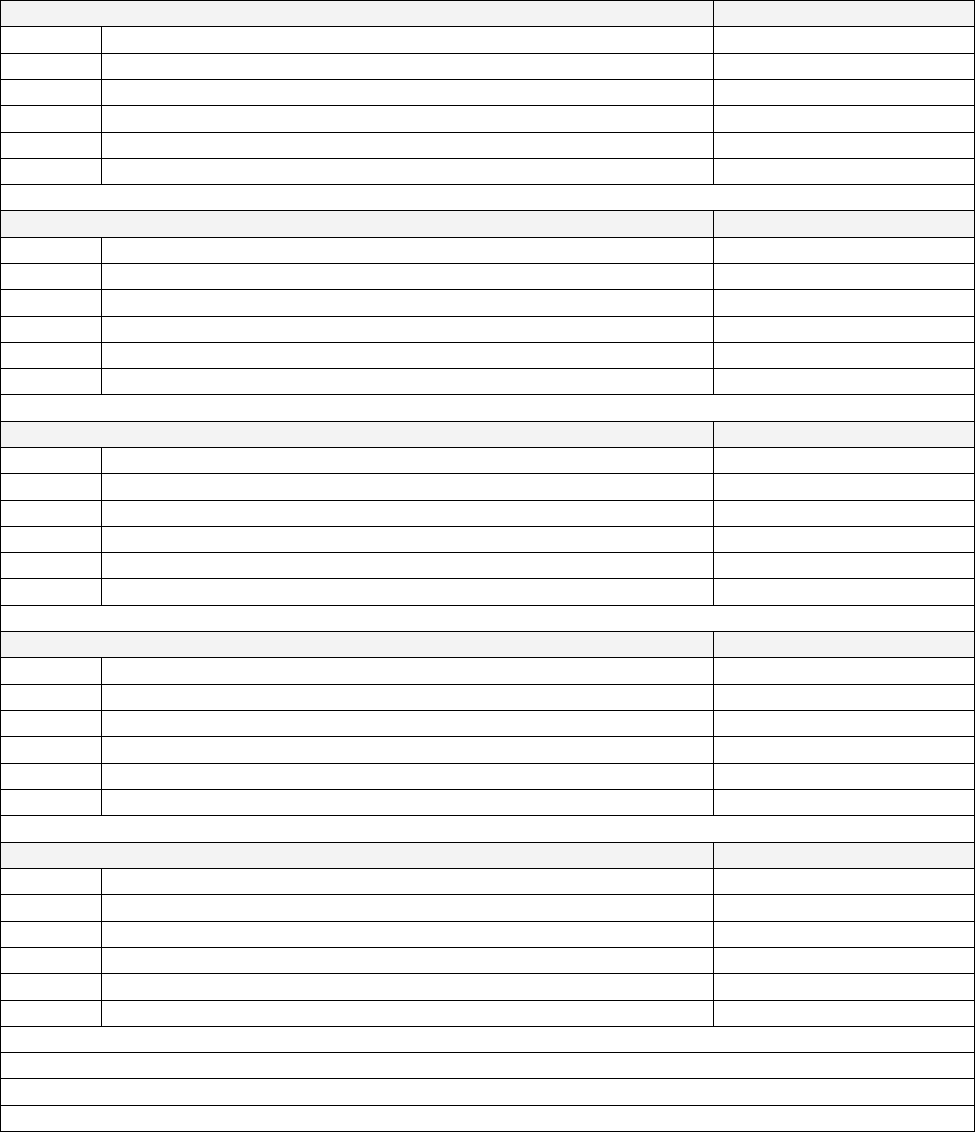
JAN 2023
47
FEP Monthly Tracking Log
___________________ ________ ____________________ ________
Member’s Signature Date CFL/ACFL Signature Date
Week 1
Date:
Activity Performed / Location
Hours
MON
TUES
WED
THURS
FRI
Weekly Results: Wgt: P/U: PLANK: CARDIO:
Week 2
Date:
Activity Performed / Location
Hours
MON
TUES
WED
THURS
FRI
Weekly Results: Wgt: P/U: PLANK: CARDIO:
Week 3
Date:
Activity Performed / Location
Hours
MON
TUES
WED
THURS
FRI
Weekly Results: Wgt: P/U: PLANK: CARDIO:
Week 4
Date:
Activity Performed / Location
Hours
MON
TUES
WED
THURS
FRI
Weekly Results: Wgt: P/U: PLANK: CARDIO:
Week 5
Date:
Activity Performed / Location
Hours
MON
TUES
WED
THURS
FRI
Weekly Results: Wgt: P/U: PLANK: CARDIO:
Monthly BCA Results: Hgt: Wgt: AC: Neck: Ab: Hips: BF%:
Monthly PRT Results: P/U: PLANK: CARDIO:
JAN 2023
48
APPENDIX G
_____________________________
GLOSSARY OF TERMS

JAN 2023
49
Glossary of Terms
1. Ballistic Stretching. Forcing a limb into an extended range of motion including
bouncing or jerking motions.
2. Cardiorespiratory. The ability of the circulatory (blood) and respiratory (lungs)
systems to supply oxygen to the skeletal muscles during sustained physical activity.
3. Circuit Training. Combines high-intensity aerobic and resistance training that is
designed to be easy to follow, target fat loss, muscle building, and cardiorespiratory
fitness. A "circuit" is one completion of all exercises in the program. Time between
exercises is short with rapid movement to the next exercise.
4. Concentric and Eccentric Contractions. Concentric is when the muscle shortens to
lift a load. Eccentric is when the muscle fiber lengthens to lower a load. Strength
training programs should include both movements.
5. Contraindicated Exercise. A movement that is potentially dangerous to the body.
These exercises are not to be performed as a part of any command-led PT.
6. Core. The muscles that stabilize the body located in the abdominal region and lower
back. Functional movements are highly dependent on the core, and lack of core
development results in a predisposition to injury.
7. Dynamic Warm-up. A 5-10 min period designed to prepare the body for the
demands of a work out or practice. These movements progress from low to high
intensity and include all planes of motion.
8. Fartlek Training. This term is Swedish for "speed play." A less structured approach
to interval training comprised of speed and fun. The session may be made up as you
go along including jogging, running, and sprints.
9. FITT Principle. The FITT principle (Frequency, Intensity, Time, and Type) is the
fundamental framework for designing physical activity programs. These four
principles are applicable to exercising at low to moderate levels and are used to
establish guidelines for both cardiorespiratory and resistance training.
10. FEP for Five. A Navy concept used to slowly introduce exercises whether to
deconditioned members or new exercise programs that utilizes small repetitions (no
more than 5 repetitions) within a set of 5 exercises.
11. Flexibility. This is the range of motion of a joint that may increase by stretching.
Stretch after your workout when your muscles are warm and pliable.
12. Functional Movement. These are movement patterns used on a daily basis.
Specific exercises can assist in preparing our body and preventing imbalances (e.g.,
plank is a functional movement that engages entire core vice crunches).

JAN 2023
50
13. Interval Training. Training that involves bursts of high-intensity work. High-
intensity work (near-maximum effort) for 3-5 minutes (may start off at 1 minute for FEP)
is alternated with periods of rest or low-intensity activity. Work-to-rest ratio should be
1:1 so a 3 minute run should be followed by a 3 minute walk.
14. Isometric Exercise. This is a type of strength training where the contraction of the
muscles occurs without any visible movement in the angle of the joint (vice concentric or
eccentric). Isometrics are done in static positions (e.g., plank).
15. Long Slow Distance (LSD). Running slowly or running for a set amount of time or
distance without regard to time.
16. Overload. Greater than normal stress on the body is required for training
adaptations/improvements to be made. Increased stress can refer to additional weight
(as in resistance training) or speed or distance (as in aerobic conditioning).
17. Pace/Tempo Training. Aerobic training at a intensity slightly higher than race pace.
This can be accomplished by setting the treadmill at a desired PRT speed with focus on
increasing duration at that speed. The benefits include improved race pace and running
economy (form).
18. Progression. This is a periodically increase in training stimulus in order for training
improvements to continue over time. The principle of progression states that there is an
optimal level of overload and an optimal time frame for this overload to occur. Too
much overload too soon can lead to injury and too little overload not often enough can
lead to training plateaus.
19. Repetition Training. This is the most intense form of aerobic training. Work
intervals are usually only 60-90 seconds separated by rest intervals of 5 minutes or
more. Typical work-to-rest ratio is 1:5. Repetition training helps to improve running
speed and running economy.
20. Static Stretching. These are techniques that gradually lengthen a muscle to an
elongated position (to the point of discomfort). Stretches (e.g., hamstring stretch) are
performed after the body is warmed up vice prior to beginning exercise.
